If you want to skip directly to the next part, then just hit
Part III - Goa, Bombay
Kovolam Beach
From the southern tip of India I went up north on the west coast to Trivandrum, while crossing from the state of Tamil Nadu to the state of Kerala. But first I had to jump to the Kovolam beach close by and jump into the water for my first swim in India.
Remark: The photos on the right side may not be correctly adjusted if you use Mozilla Firefox or Chrome. I propose to use the Explorer of Microsoft instead.
Click the small picture to get it enlarged
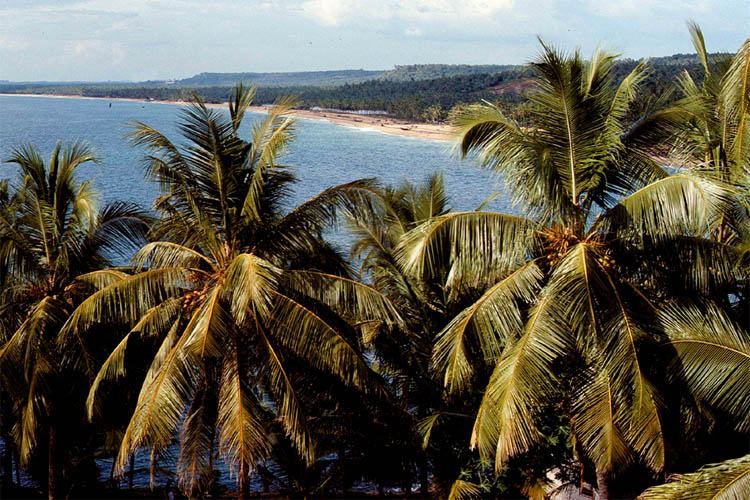
| Finally Trivandrum I was happy to reach
|
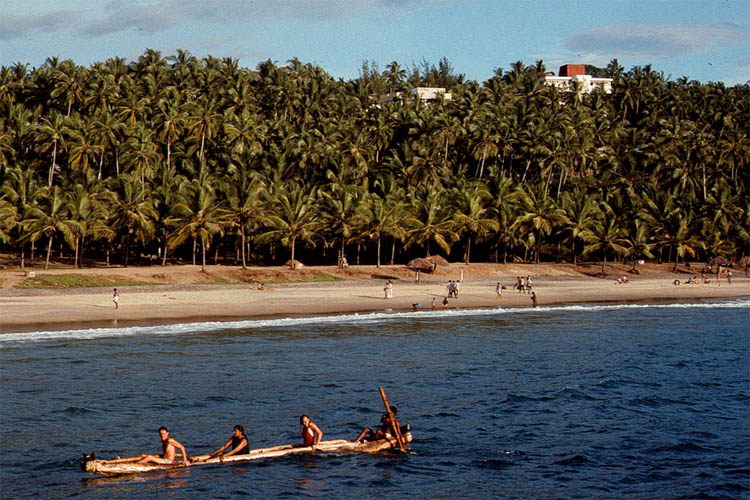
| meaning relaxation on the Kovolam beach
|
This beach is actually one of three worthwhile beaches in India, ranking between Goa (see next part) and Puri (see India 1994). This place, though small, offers almost everything for the traveler: cheap accommodation and restaurants, massage service and boat rental, folklore entertainment.
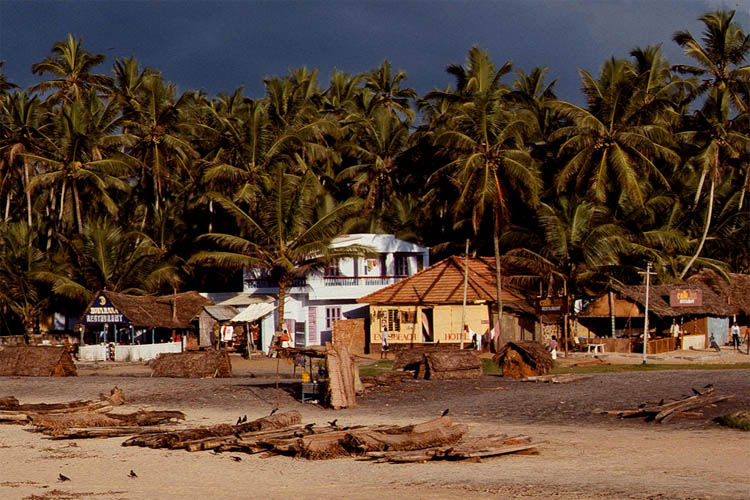
| There are hotels and restaurants a lot
|
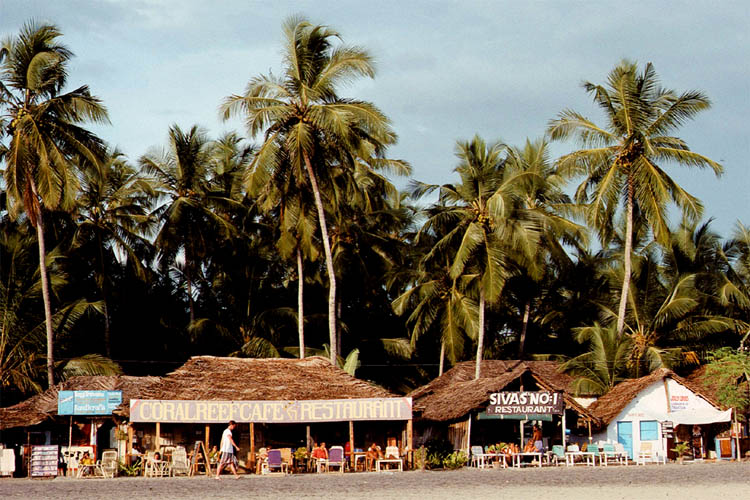
| because this is a famous traveler's spot
|
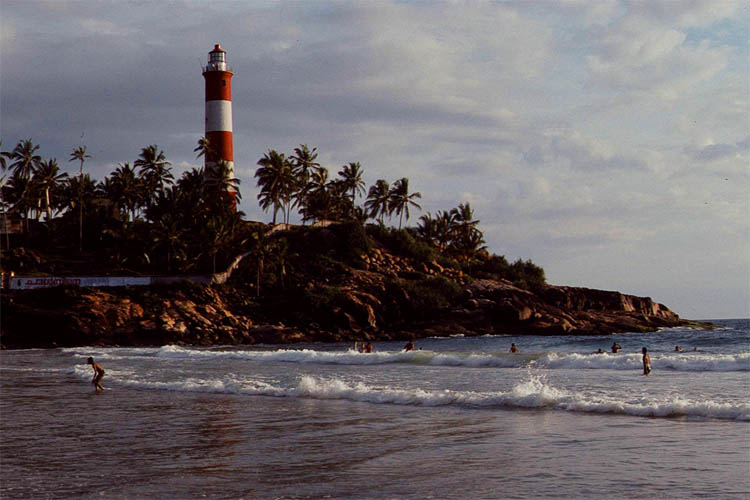
| The light tower will soon be switched on
|
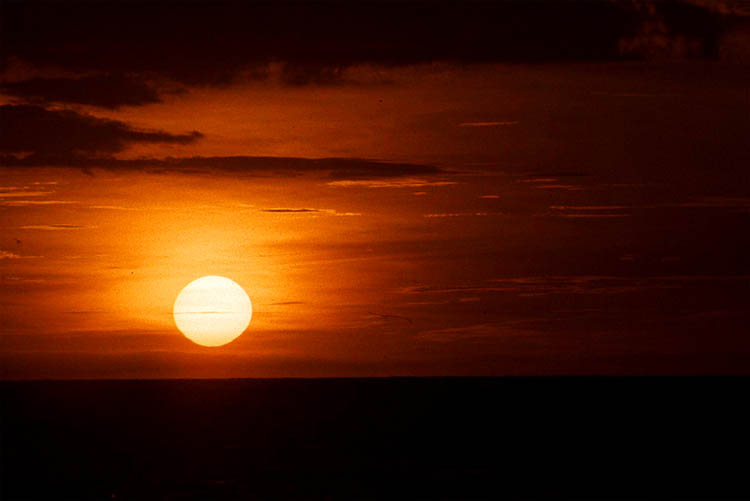
| And the sun will soon go down
|
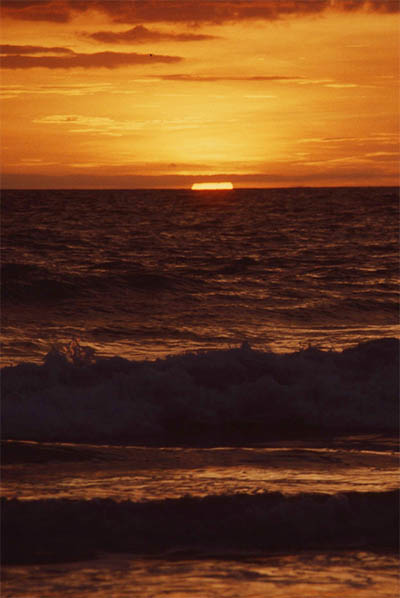
| With the beautiful sunset over the sea
|
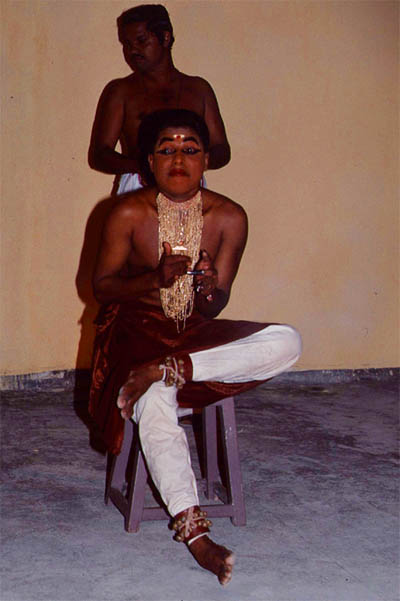
| He is getting ready for the Kathakali
|
What to do after sunset? Going to the movies, or better silent movies. Yes, it is about moving, or better a theatrical performance in mime, that's Kathakali. Actually being played for local audiences the whole night, but for the tourist it is not longer than a movie, even if it takes the actors two times as much to get prepared for the show.
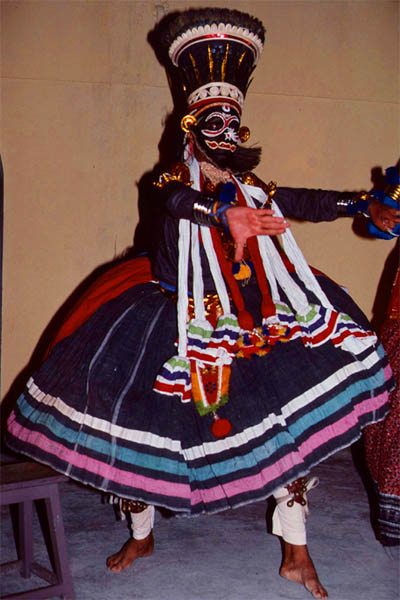
| A mime play with demons
|
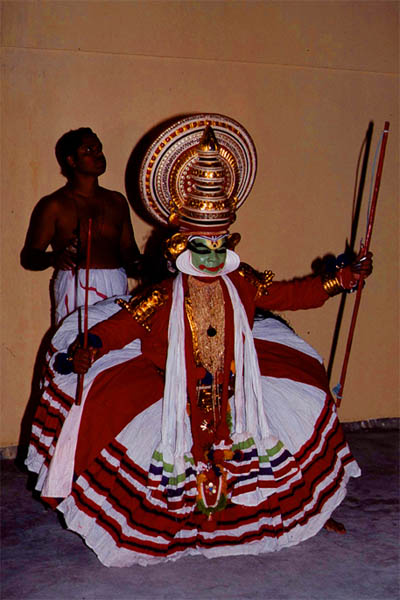
| and, of course, heroes
|
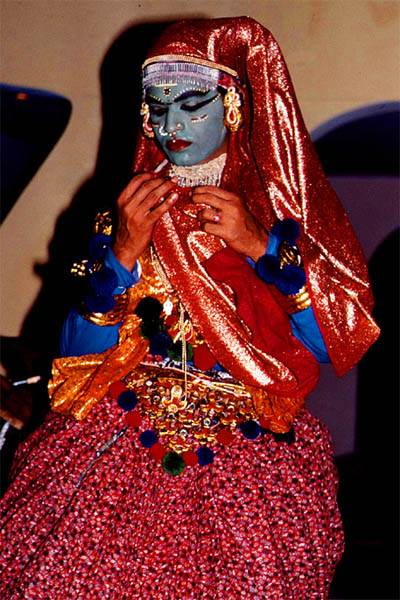
| Always part of a play is a mistress
|
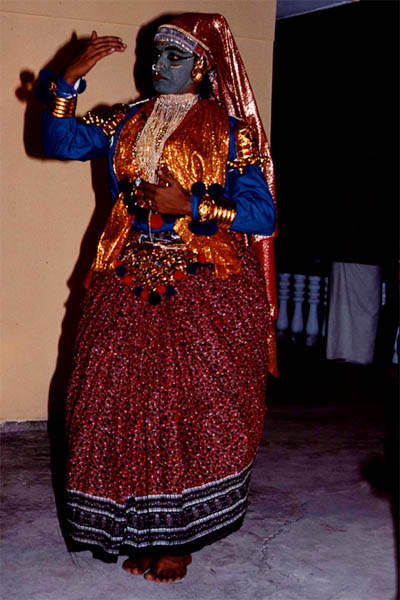
| though a man will play this princess
|
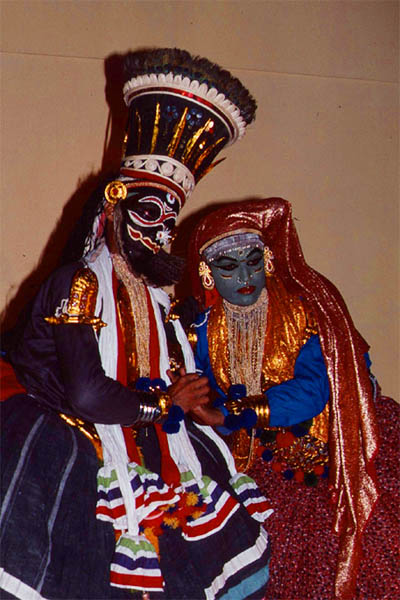
| A little bit confusing is this kind of drama
|
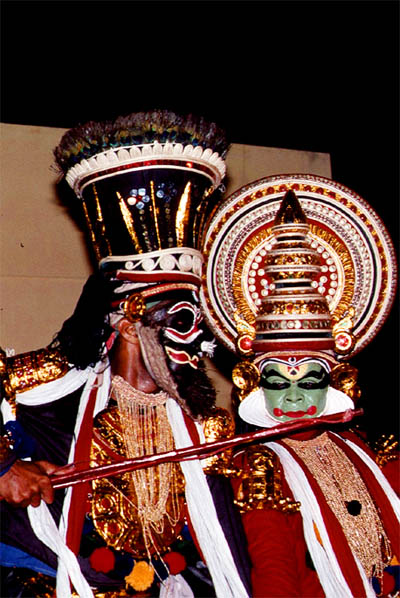
| consisting of Mahabharata and Ramayana
|
The beach has not been fully taken over by the tourists, yet. Fisher folks still keep the beach also as their fishing grounds, which unfortunately doesn't yield much.
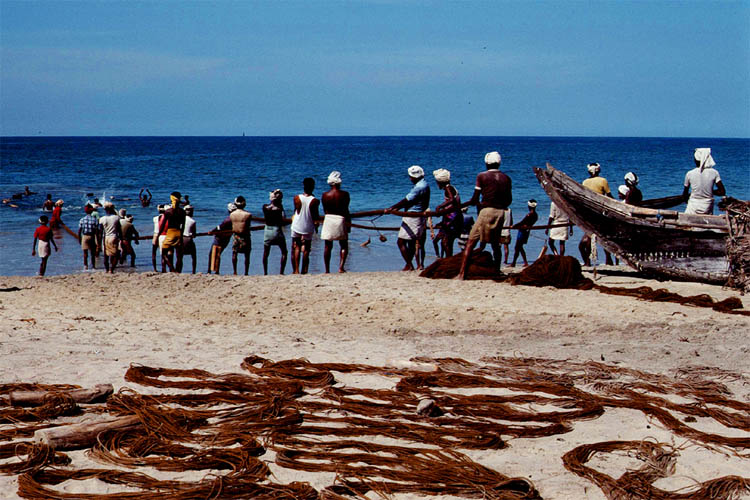
| That must be a big catch to be hauled in by almost 50 men
|
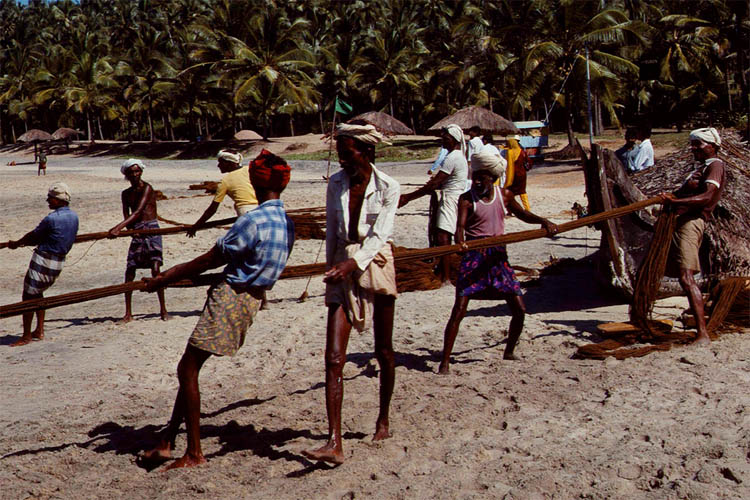
| Everybody seems to help by pulling as much as they can
|
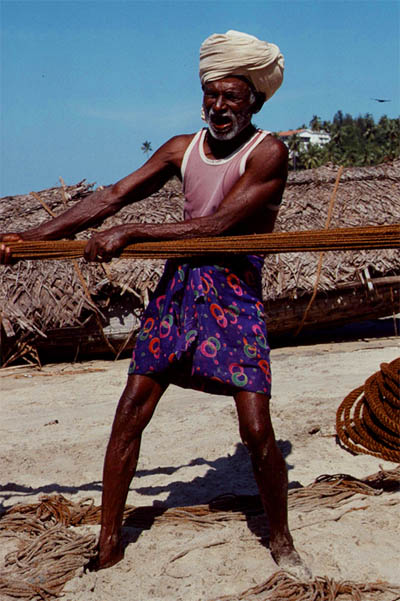
| He is really trying hard to pull in the catch
|
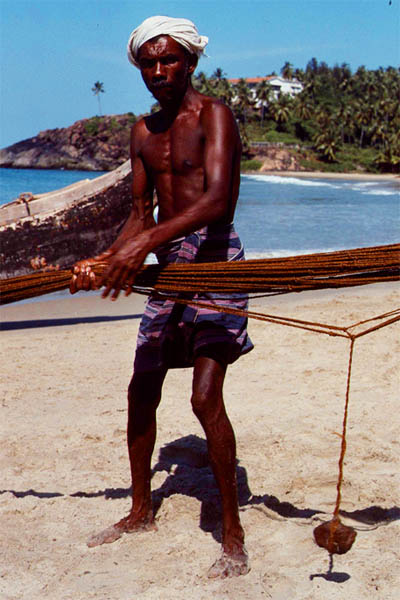
| The guys have really skinny bodies I cannot match
|
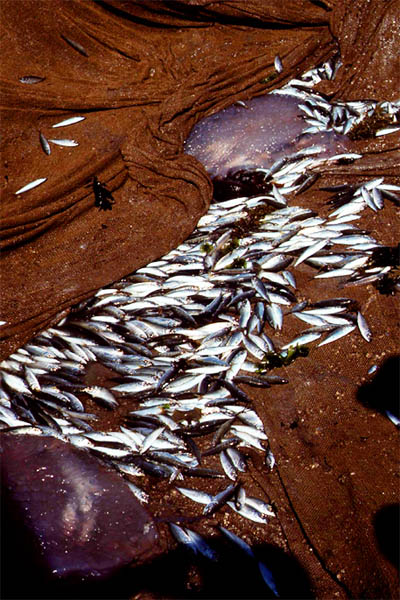
| The result was even more meager with skinny fish
|
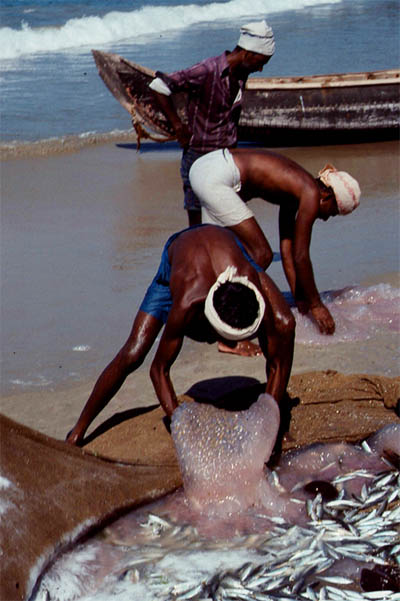
| There was more jellyfish but that wasn't a delicious dish
|
After two nights I had relaxed enough. Besides, I didn't come to India for the beach. Rather looking for more adventure (or danger?).
Trivandrum
So I continued my trip up north. First to Trivandrum, one of the bigger cities with almost a million inhabitants. Not my thing, despite some worthwhile sites. I rather hopped on a bus on my way to more nature.
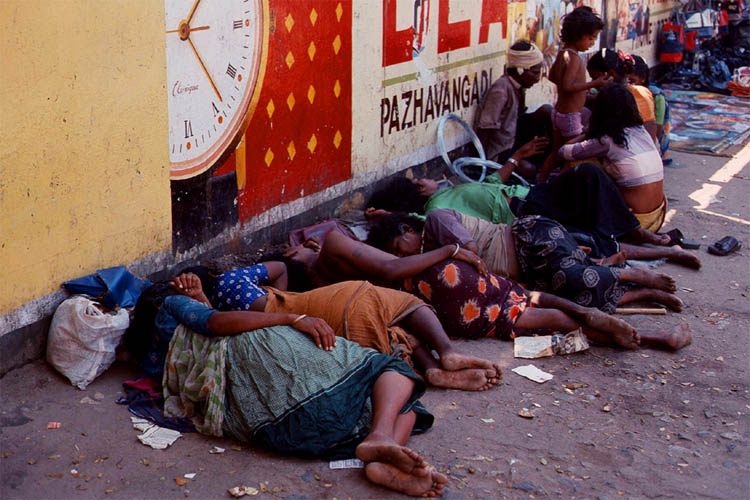
| Now, I had enough ralaxation
|
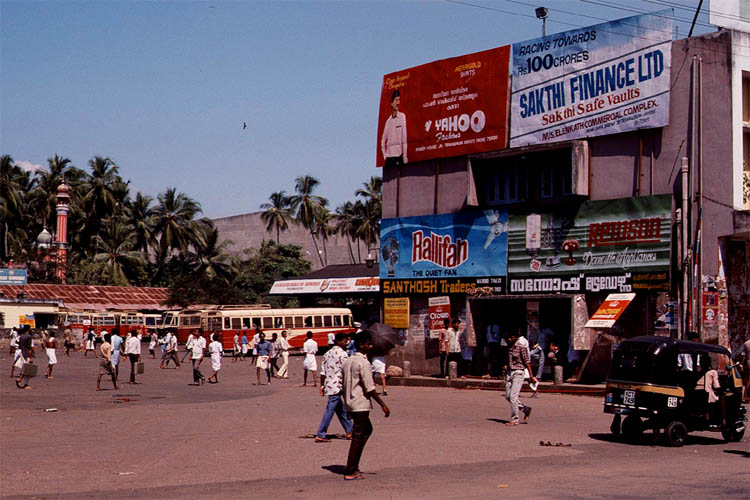
| I was pulled to the bus station
|
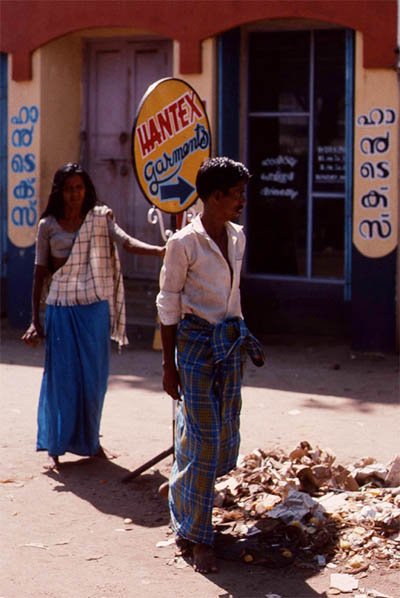
| This couple had started a street fight
|
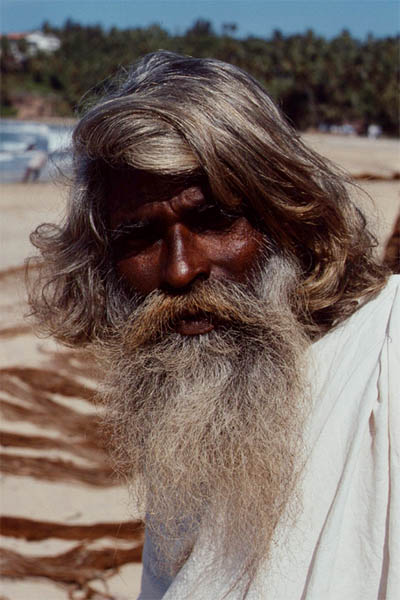
| That guru has rather peace in mind
|
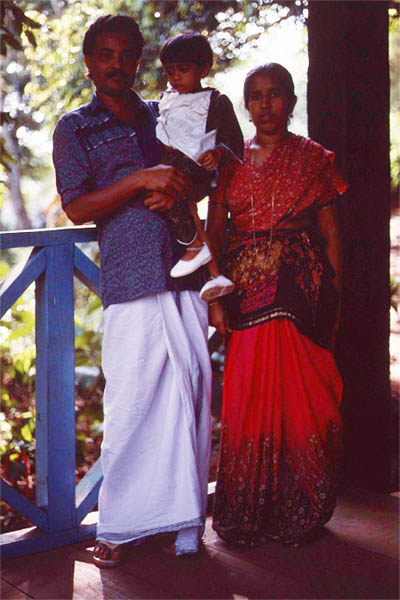
| Indian wives not always look too happy
|
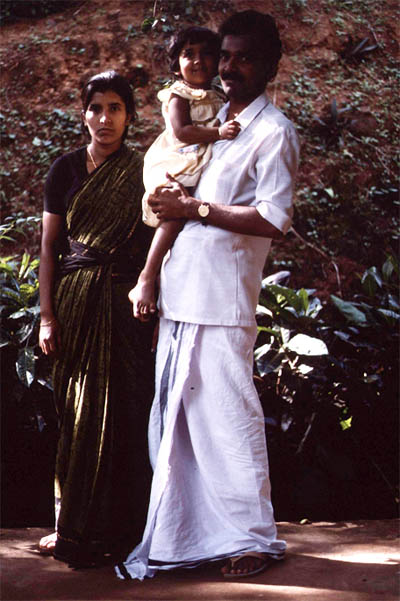
| Husbands have more to say in the family
|
Periyar
I arrived at the Pariyar Tiger National Park, or Wildlife Sanctuary, late in the evening, because I had to change buses several times. Next day I was ready to face the tiger. But how? By boat, by elephant or by monkey jeep?
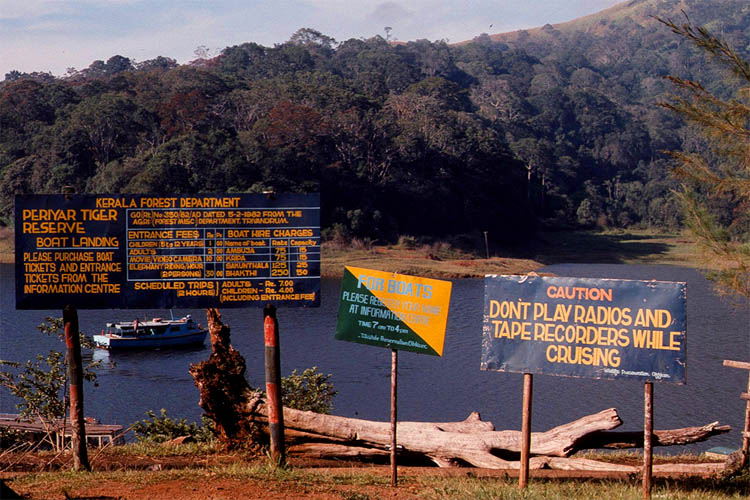
| What to do at the Periyar Tiger National Park first
|
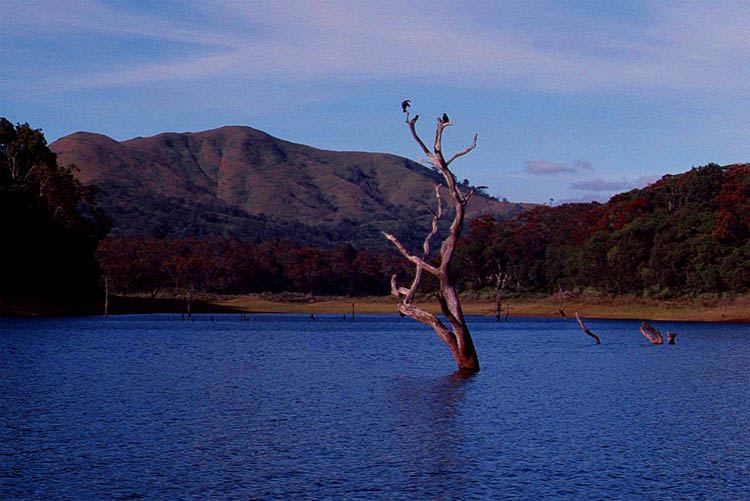
| I decided to join a cruise on the lake but only saw birds
|
Where are all the wildlife animals? There are supposed to 750 elephants and 36 tigers, beside bison, antelopes and wild boars. Didn't see any of them, except for a tamed elephant and some really nosy monkeys. No wonder: the sanctuary has 777 sq km including the artificial lake, all created by the British, the "good colonialists", but by chasing out tribal groups beforehand (by the "bad colonialists), thus the animals have enough room to roam around.
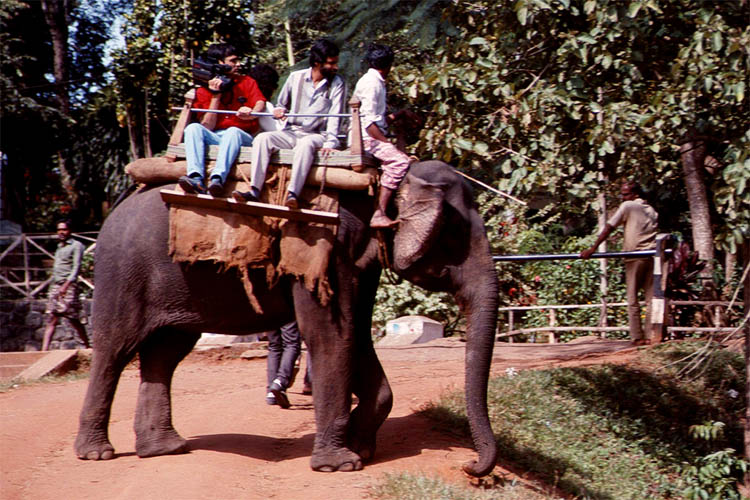
| Should I then go on an elephant safari?
|
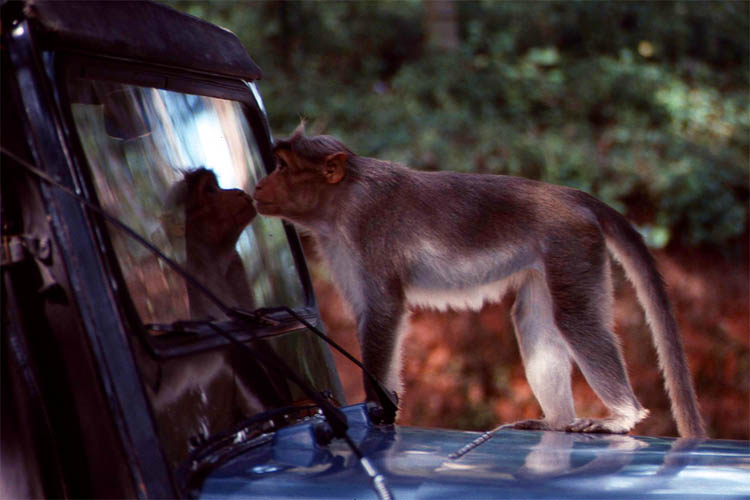
| Or rather join a monkey jeep safari?
|
No tiger in sight. Do I have to find him by foot. Maybe he comes out by posing as a bait to him myself. Wasn't that a bit suicidal? Ok, maybe the tiger wouldn't choose me, so I joined a trek with five programmers from Bombay with a guide.
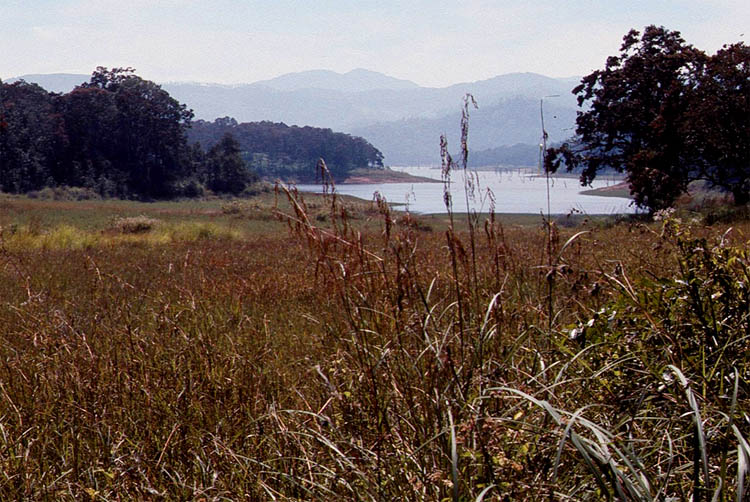
| The only way to encounter a tiger is going by foot
|
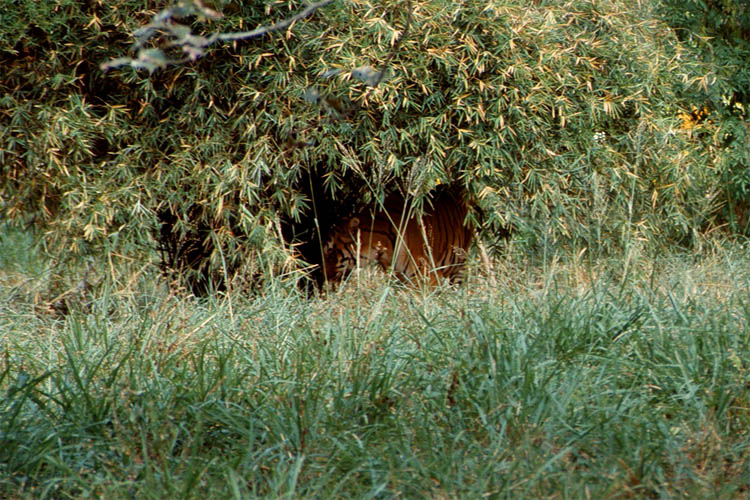
| Then I saw my tiger as out of the woods he looked
|
I survived. Because we really didn't see a tiger but only his foot prints. The photo of the tiger above was shot later in the zoo of Mysore. But before I did get there I plied the famous backwaters of Kerala.
Kerala Backwaters
I went by bus to Kottayam to embark on the famous Kerala's backwaters on the way to Alleppey (new name is Alappuzha). The backwaters are a vast network of rivers, canals, lagoons and lakes.
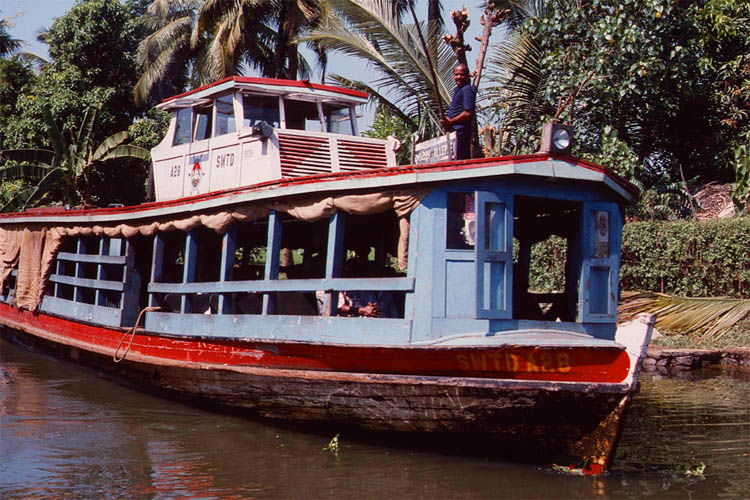
| Got on a boat after escaping the tiger
|
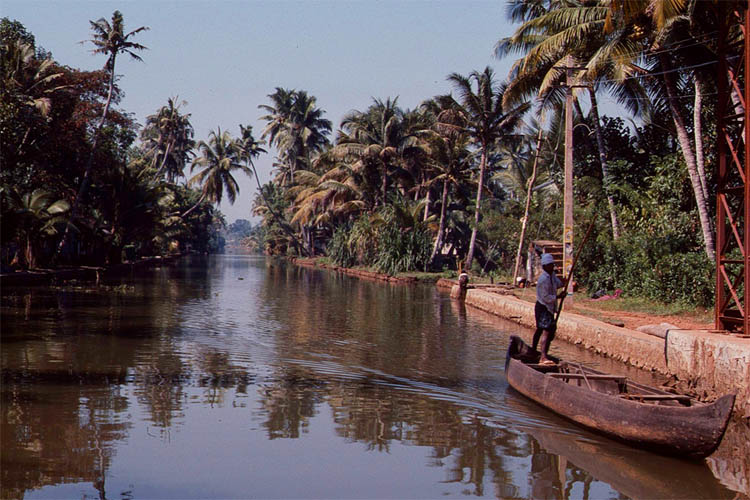
| To ply the backwaters of Kerala
|
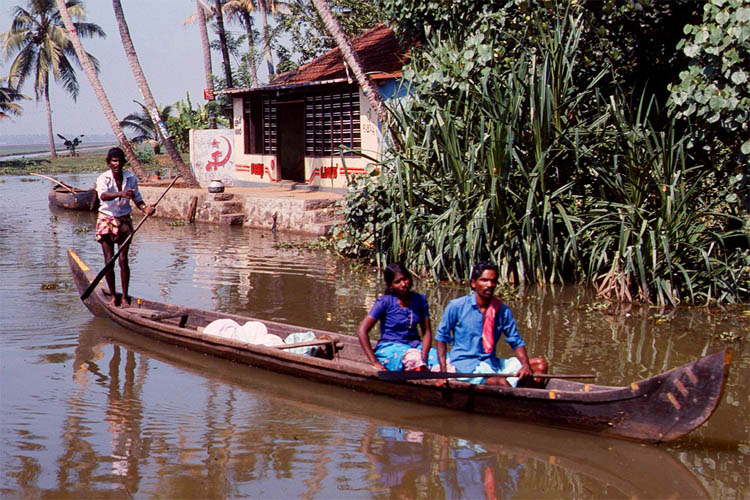
| The boats are moved by paddle or stick
|
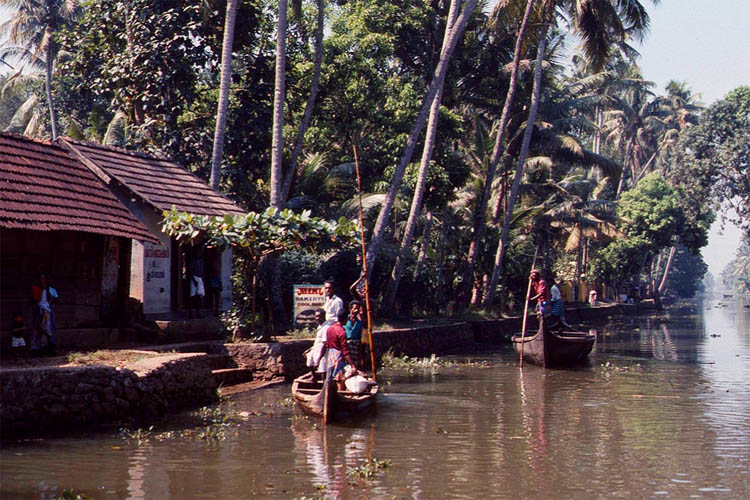
| The boats are a good workman-ship
|
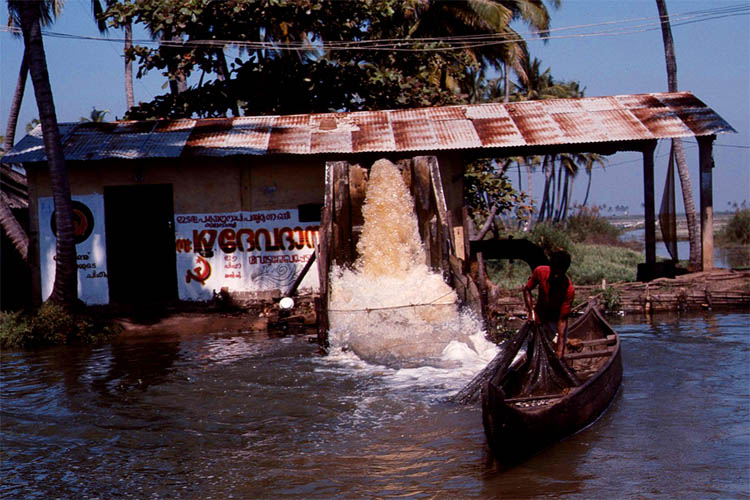
| Also in the waterways some fish they yield
|
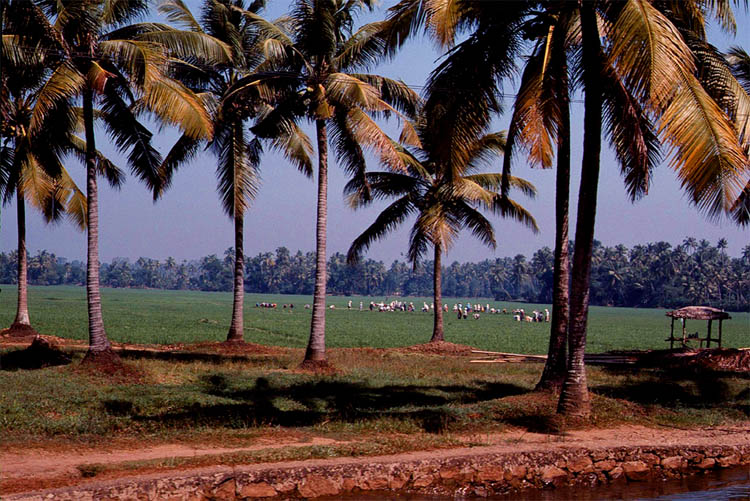
| The people are working hard in the field
|
Believe it or not. The state of Kerala has a freely elected Communist government. And believe or not, Kerala is one of the wealthiest states and has the lowest illiteracy rate in India. Not that the richest get richer, like in other countries, but the wealth, like land and income, is more equally distributed between their inhabitants.
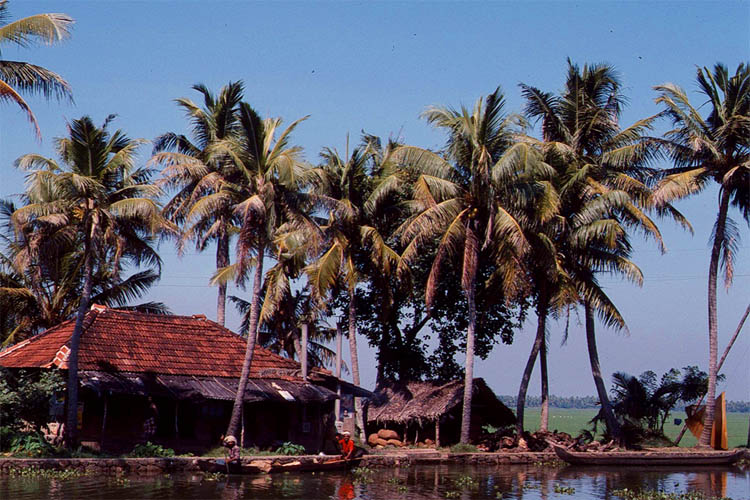
| Some outposts are collecting the harvest
|
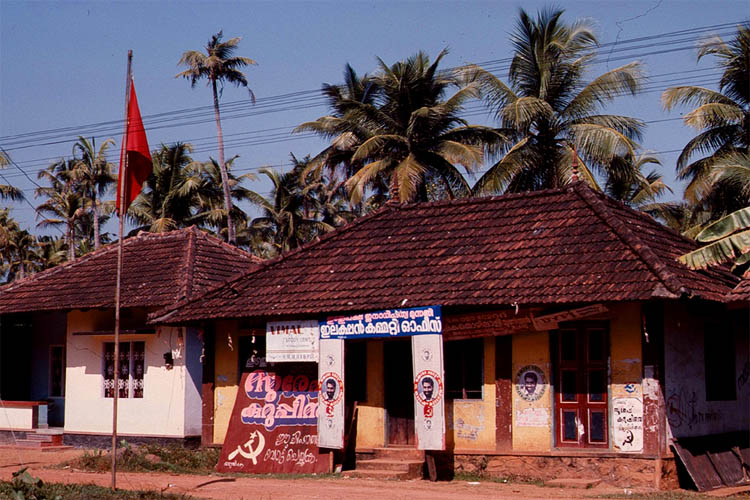
| All is still controlled by the communist
|
Cochin
Next big city: Cochin. Also a big harbor with a long history. Arabs, Chinese, Portuguese, Dutch and British have come here centuries ago for trade and some settled down, which houses can still be seen in the older parts. It also was very tolerant city at that time. All religions lived close by in peace. You can see the oldest church in India, old mosques and a synagogue, all built around the 16th century.
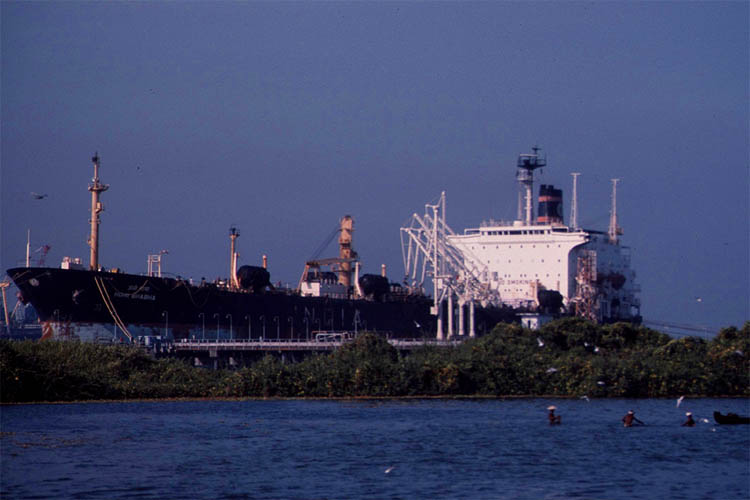
| Big ships moored in the harbor of Cochin
|
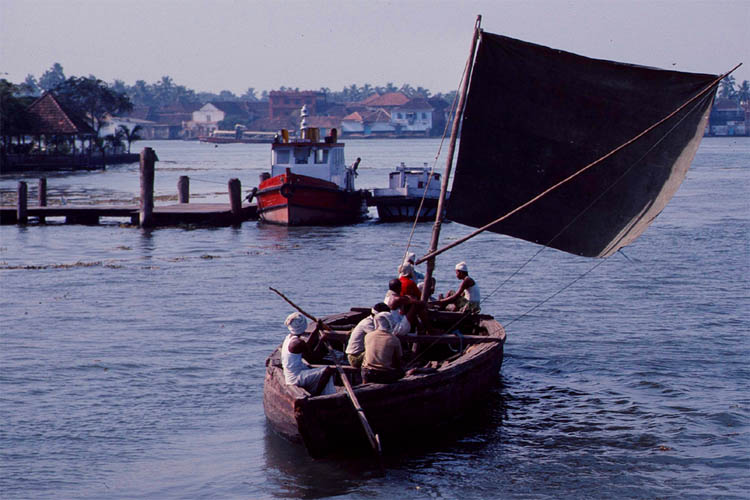
| Also many small sail boats can be seen
|
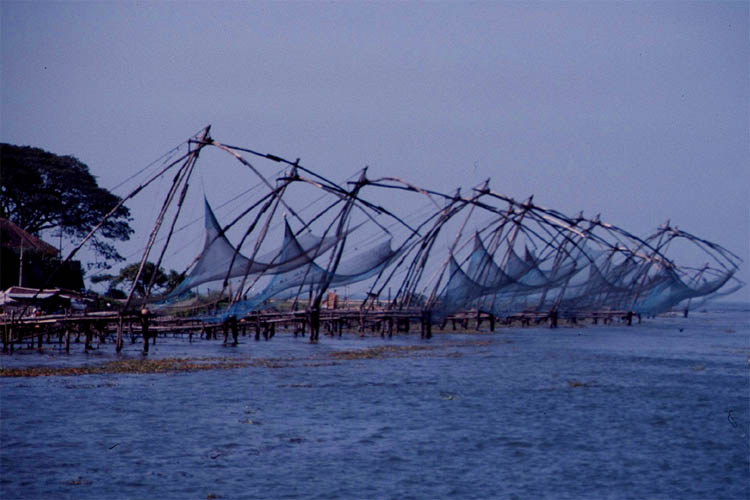
| This is a clever way to catch fish
|
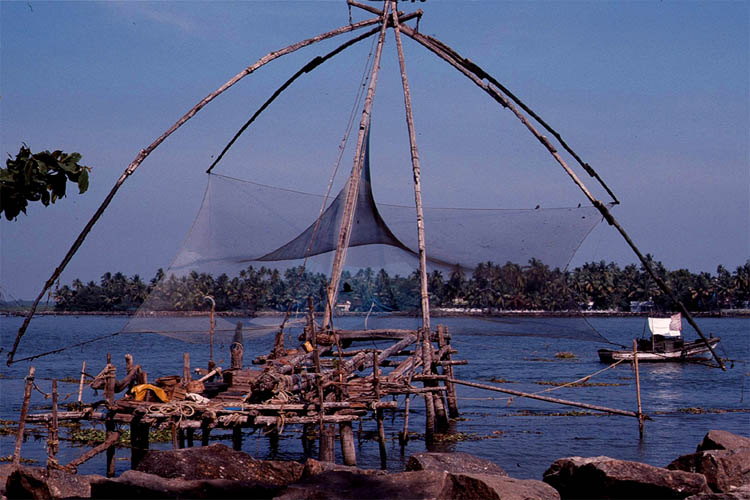
| Let the net into the water and then lift it
|
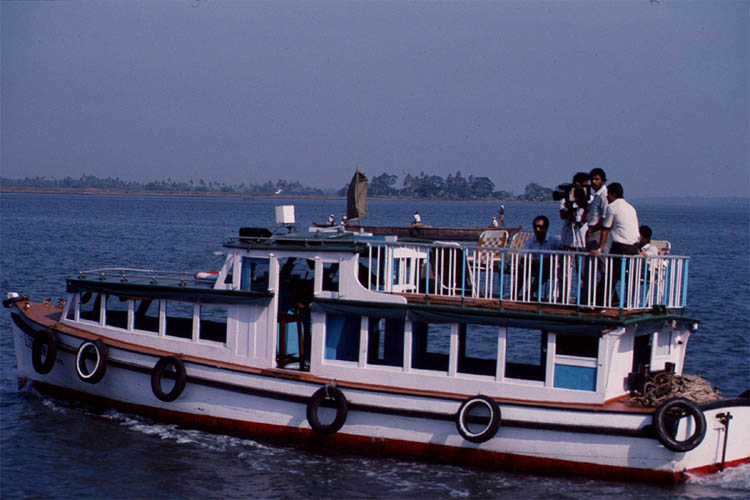
| Being filmed during the harbor cruise
|
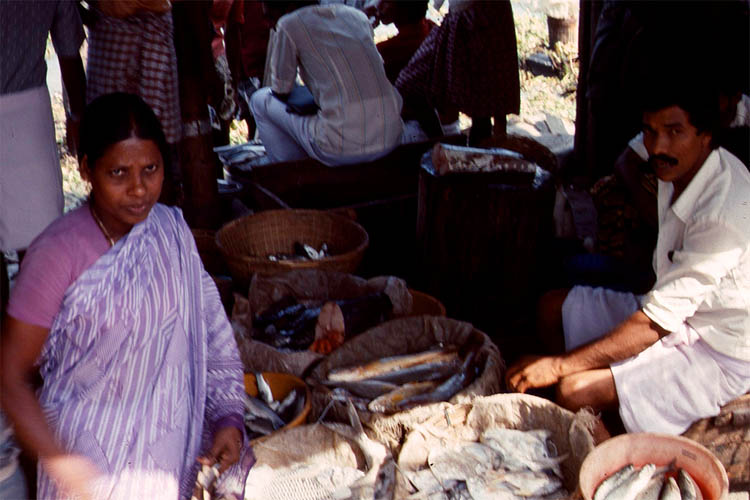
| The fish market is also very close
|
The following photo shows the St. Francis Church built in 1503, where Vasco da Gama, who died in Cochin 1524, was buried here for 14 years before he was moved to Lisbon. His tombstone is still there.
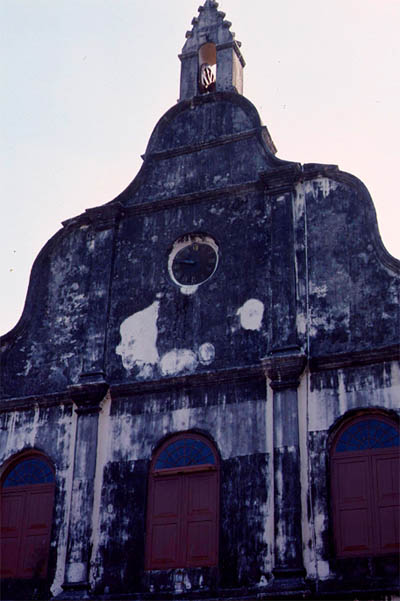
| This is the famous St. Francis Church in Cochin
|
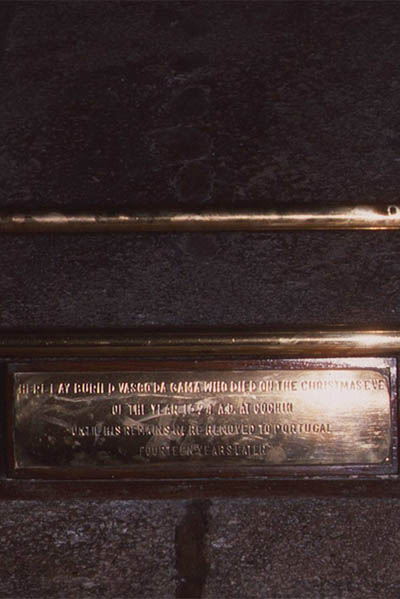
| And under this tombstone was Vasco da Gama's coffin
|
An old Jewish synagogue still exists. The surrounding Jewtown was and still is the spice trade center and many Jews are still living here.
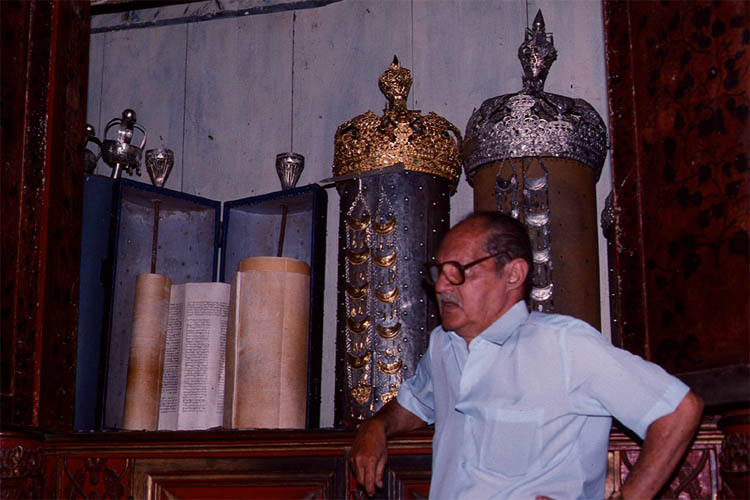
| These are one of the oldest Tora scripts, not the News
|
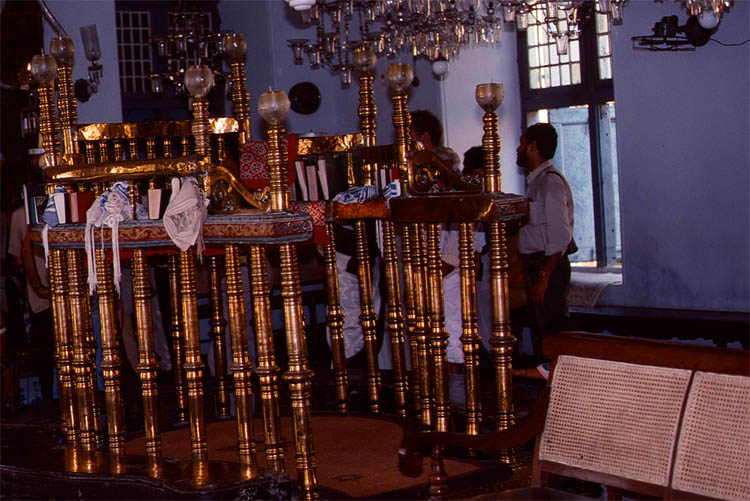
| in a synagogue of the old quarter of the Jews
|
Ooty
After a one-night stopover in Cochin I continued my journey to Ooty, or Udhagamandalam, the summer retreat of the British and of the Maharaja of Mysore. So I also stayed as comfortable as possible in this cool mountain resort in 2200m: in the Maharaja's summer palace.
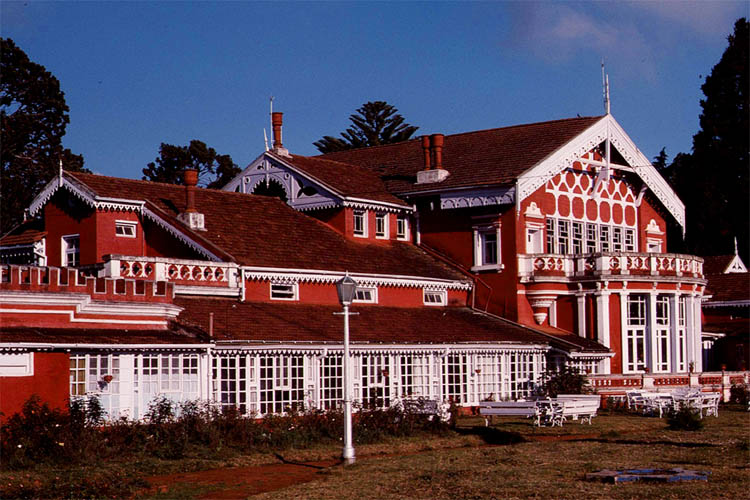
| The summer palace of a maharaja
|
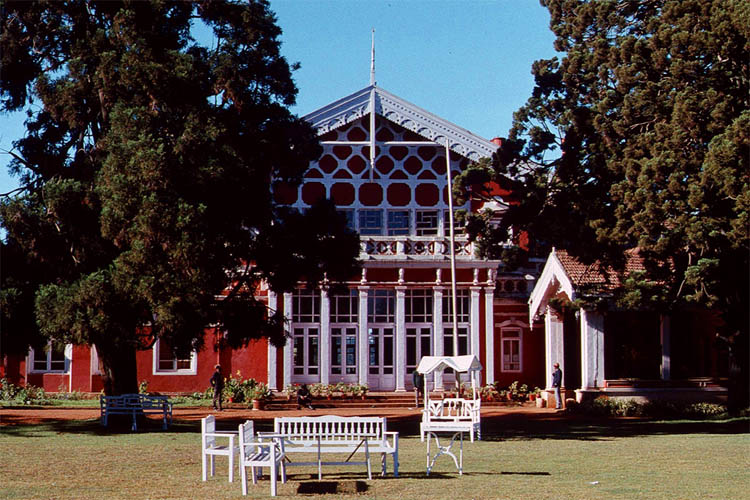
| where I also stayed like a pasha
|
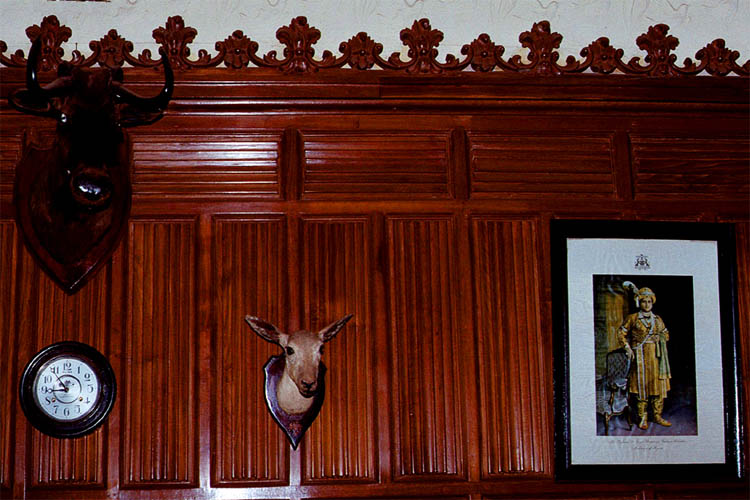
| A photo of the owner and his trophy
|
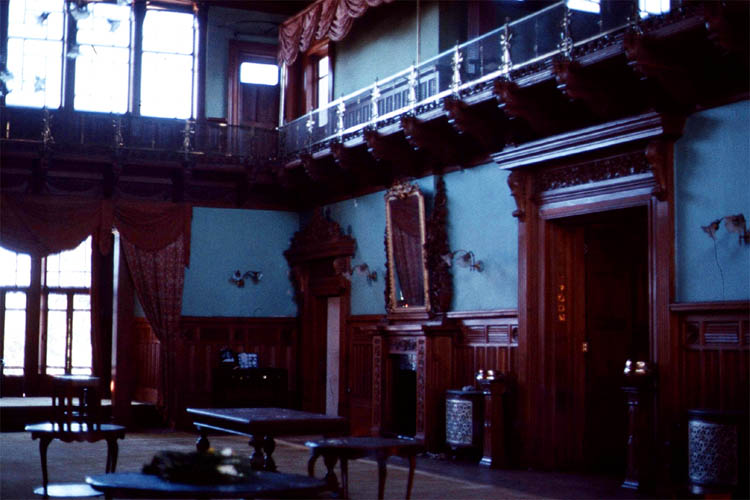
| This is the antique salon or lobby
|
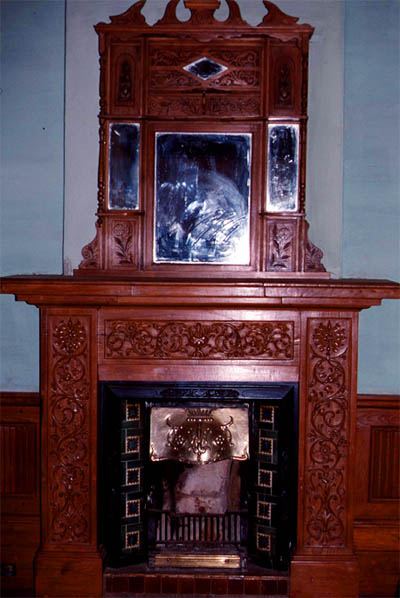
| A fireplace was also used temporarily
|
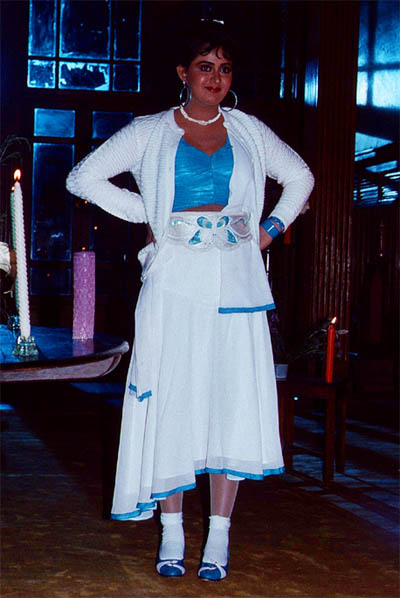
| But this was not part of the inventory
|
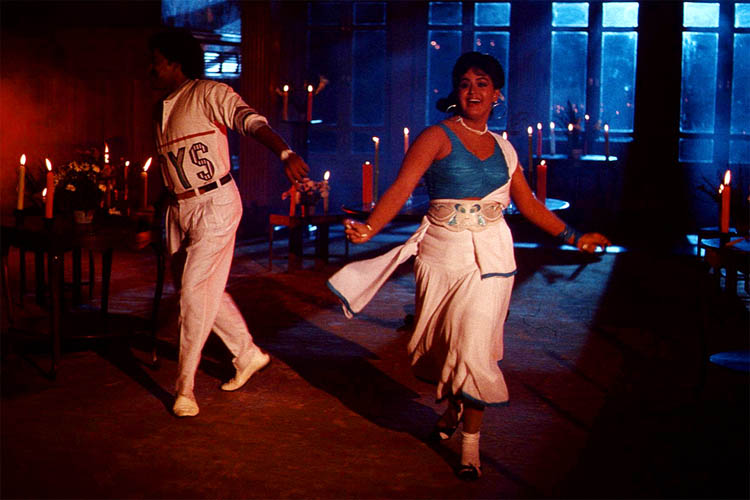
| She played a part in a Bollywood movie
|
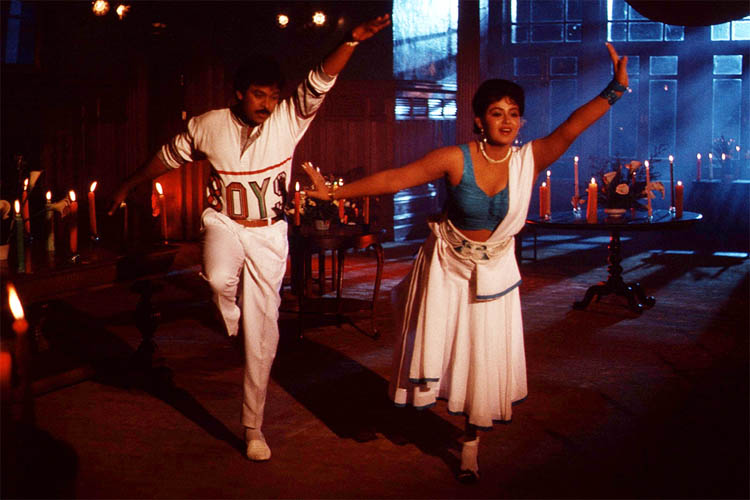
| just being shot by a Madras film crew
|
Most Bollywood actresses and actors are well rounded around the waist. The Indians find that sexier than skinny western types.
It also might be even sexier for a wife of having more than one husband. It is called fraternal polyandry. Yes, that was true with the Toda tribe, where a woman marries all the brothers of a family. And one village of that tribe was not far away from Ooty, just behind the botanical garden and then up the hill.
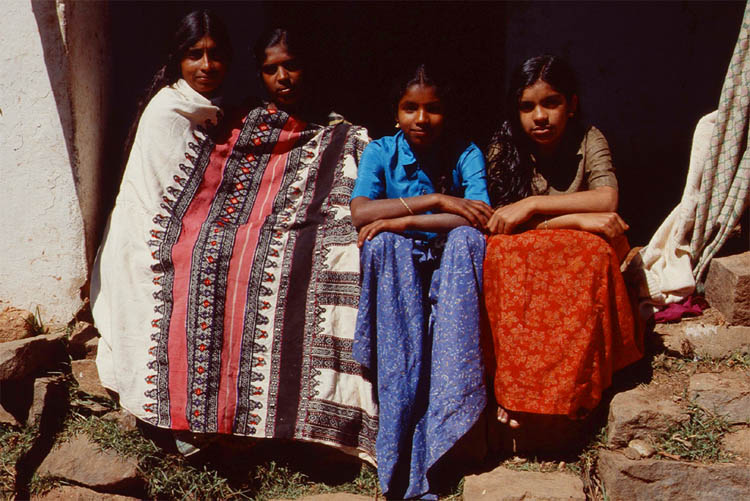
| If you are interested to marry one of those wives
|
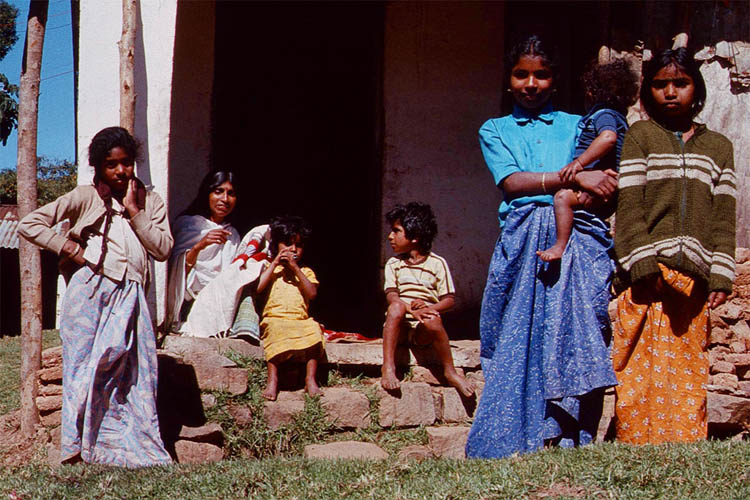
| You can do that even if she has already one or two guys
|
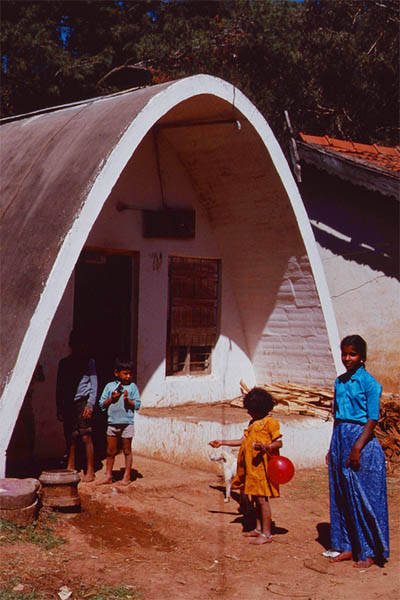
| Would you like to live in a house like this
|
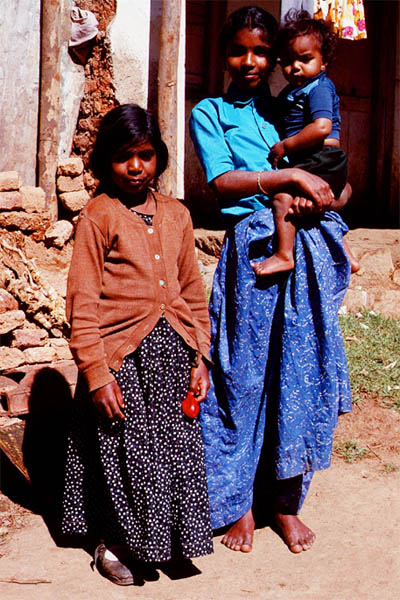
| with your wife and two men and a mix of kids?
|
I don't understand why fraternal polyandry is not practiced anymore, because there are still supposed to be almost double as Toda males around as females (don't ask me why).
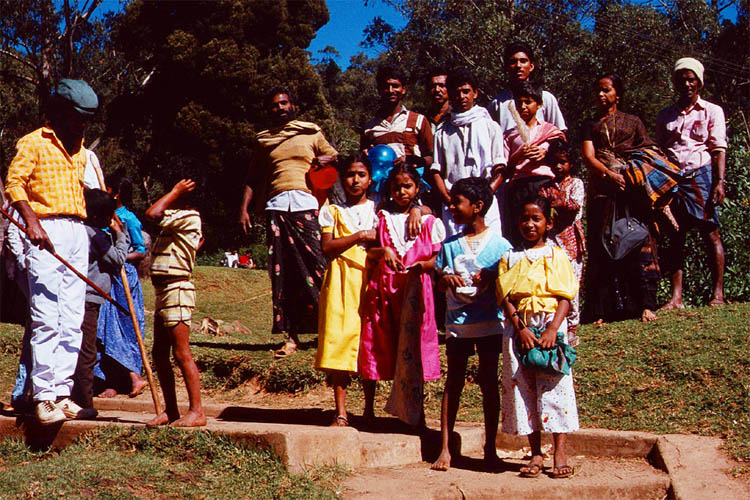
| More men and kids than women seemed to be around
|
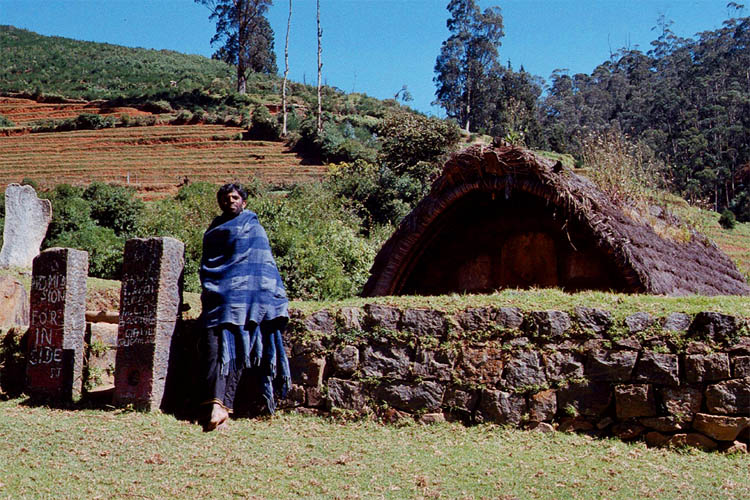
| Men are still the guardians of this sacred ground
|
They live from veggies and the dairy products of their buffalos, which are also sacred. They seem to have their own religion with many gods (like the Hindus) worshipped in some kind of a temple, built in the same fashion as their dwellings and surrounded by a stone wall.
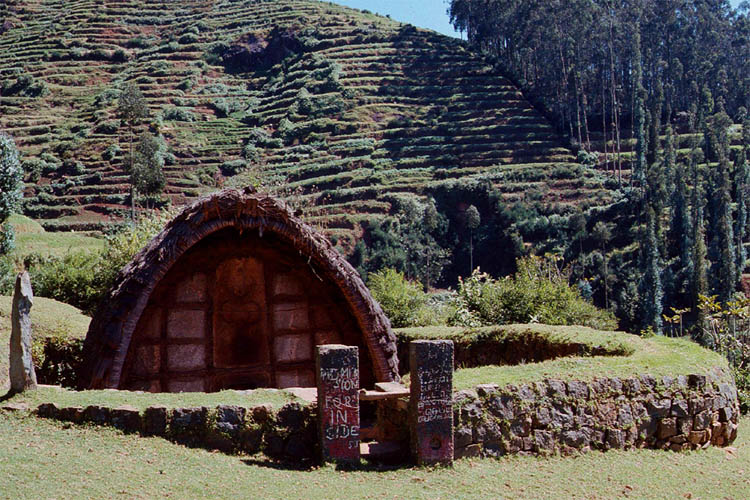
| The small entrance to the sanctum
|
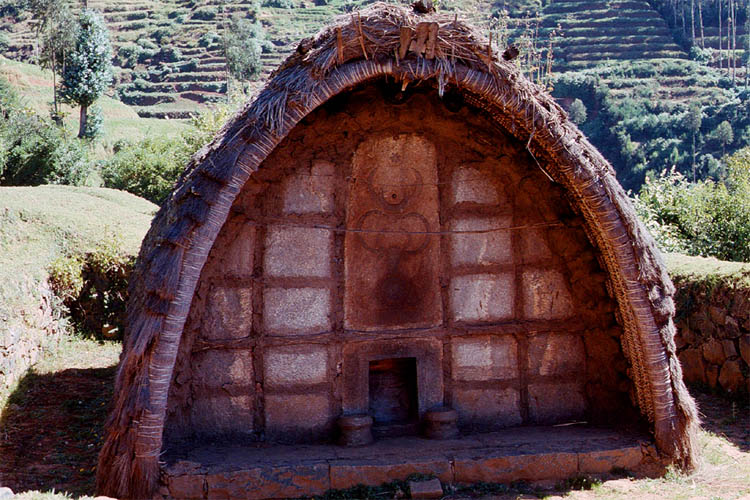
| can only be entered by a skinny man
|
The "priest" who showed me around could only speak a little English, thus I didn't understand the meaning of the stony eggs lying and the erections standing on the ground.
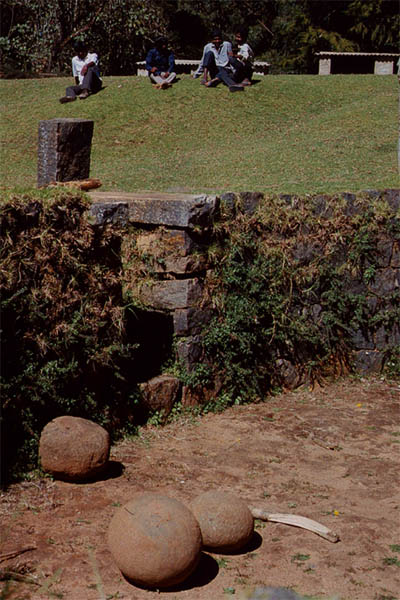
| Who has laid the eggs?
|
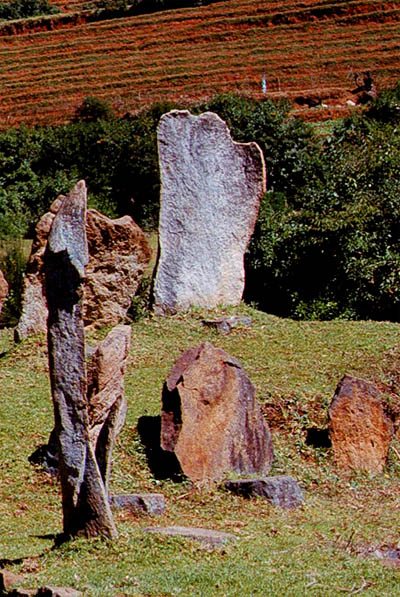
| Who has erected the menhirs?
|
So they almost still live like their ancestors and seem not to be too much influenced by the close proximity of the worldly town of Ooty.
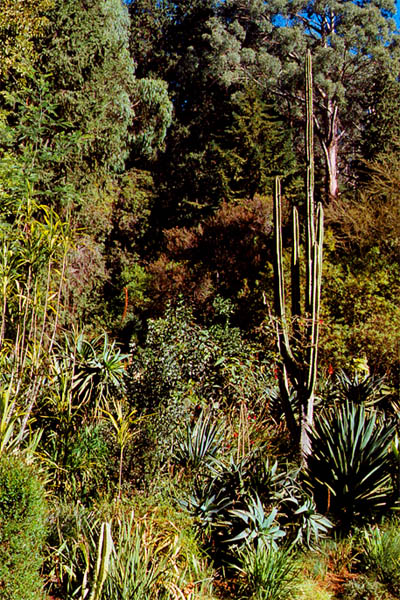
| Walking through the botanic garden on my own
|
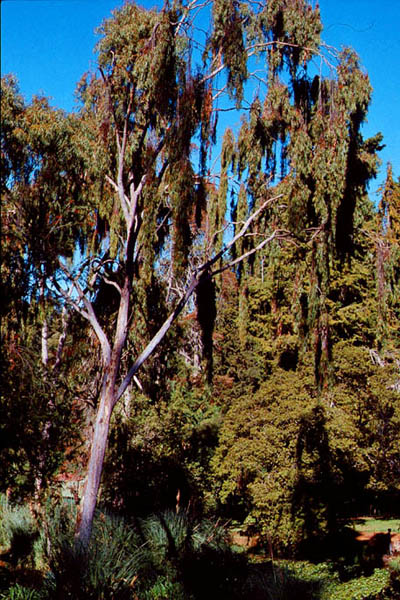
| I think about that tribe before getting back to town
|
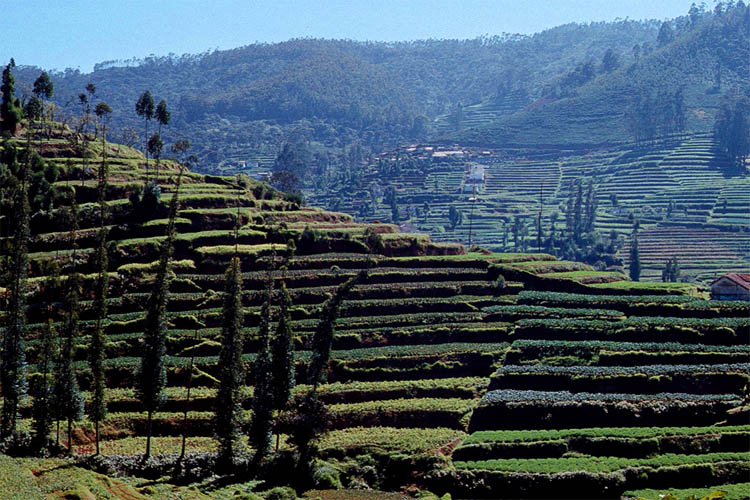
| After wandering through a beautiful countryside
|
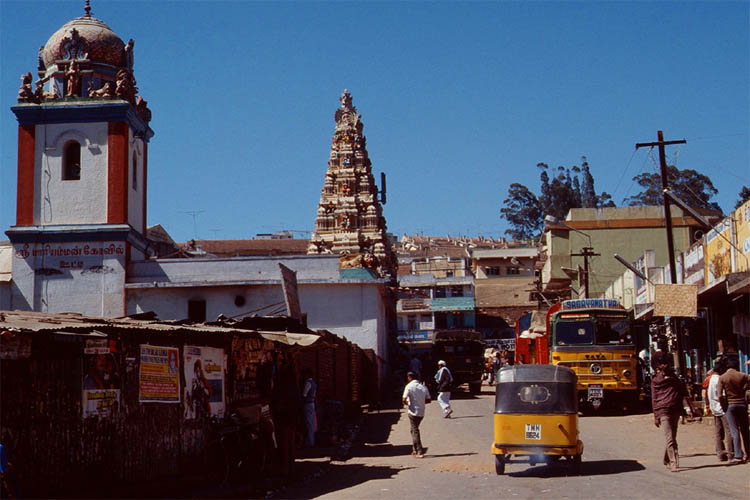
| I am going to investigate the town's life
|
Thinking of the Toda tribe again. Their religion still exists beside Hinduism and Christianity in this area. This part of India seems to be very tolerant to other religions.
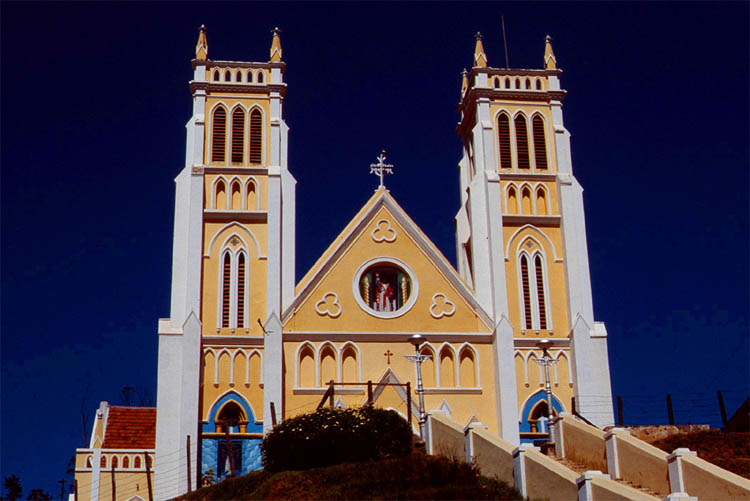
| A fancy church. The inhabitants are very tolerant
|
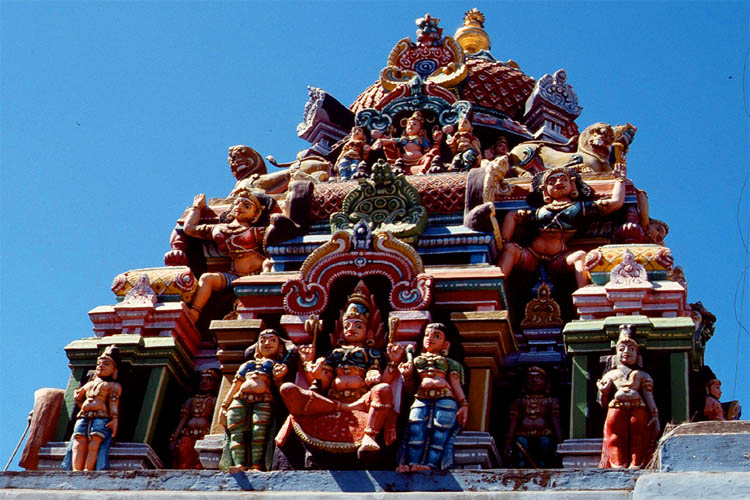
| A colorful temple. Hinduism is still prevalent
|
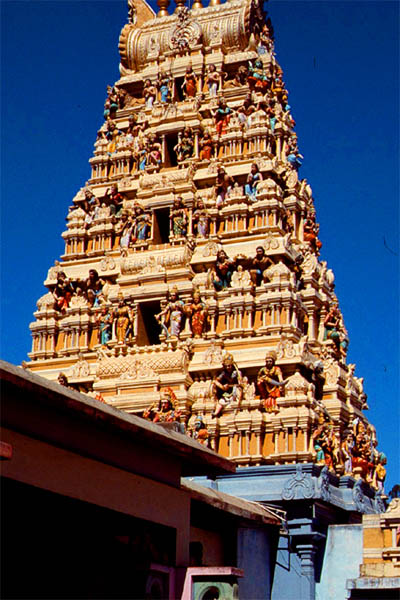
| In the midst of town temples arise
|
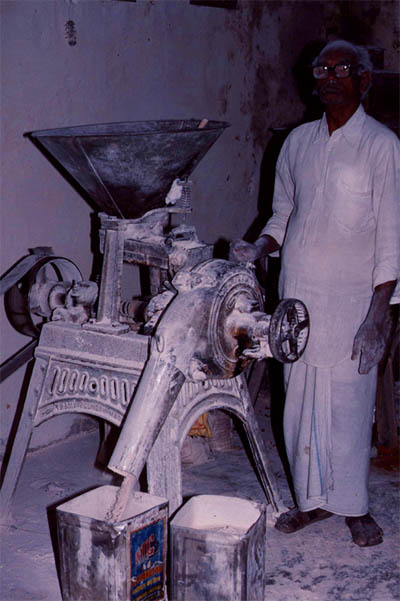
| Almost next door to a milling enterprise
|
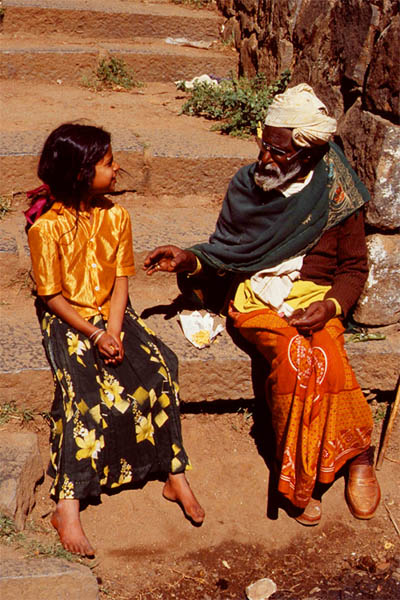
| They are having a conversation in Hindi
|
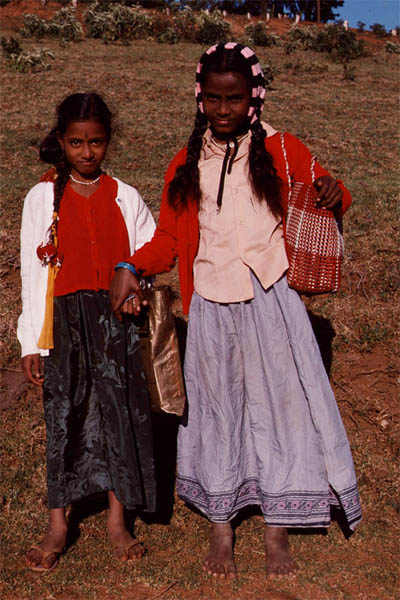
| These sisters look a little bit gipsy
|
Ooty has much more to offer. Yes, it is a summer retreat with a racecourse, a lake (with boats to be rented), and lots of nature around.
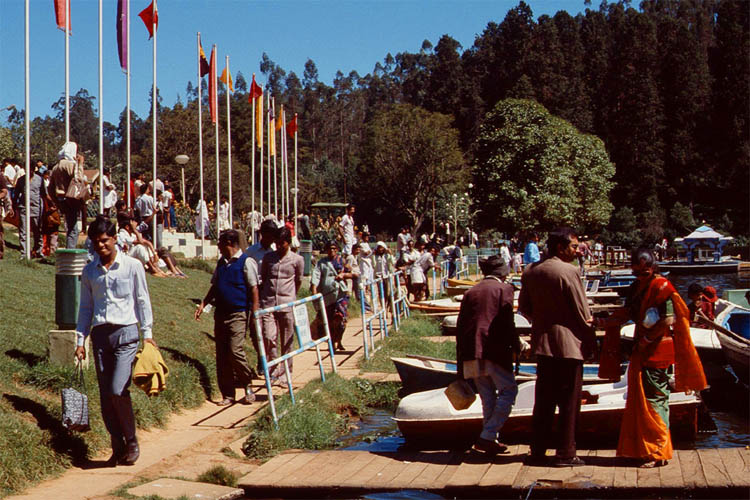
| Some happy places are around Ooty
|
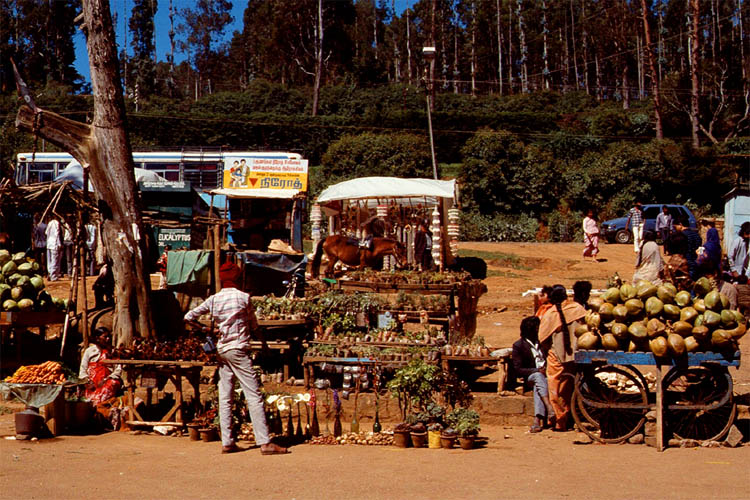
| and many stalls with tutti frutti
|
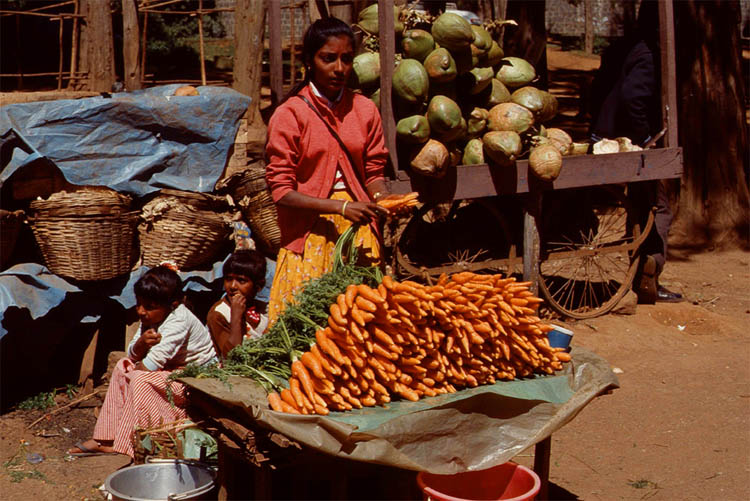
| Free markets
|
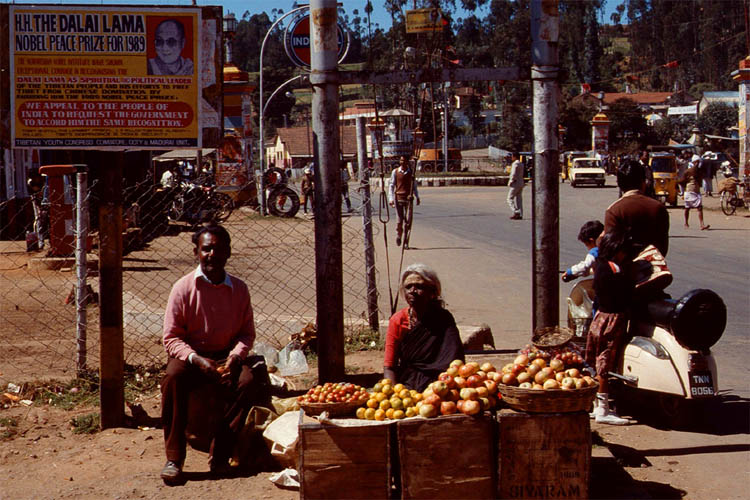
| everywhere
|
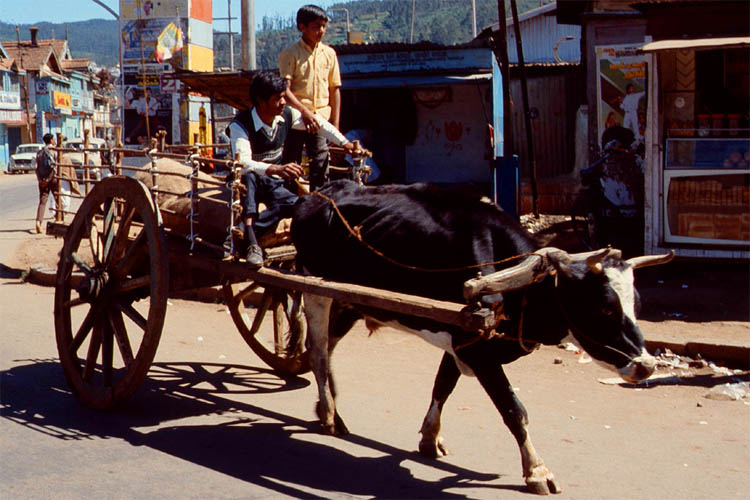
| It's time to leave, not by ox cart
|
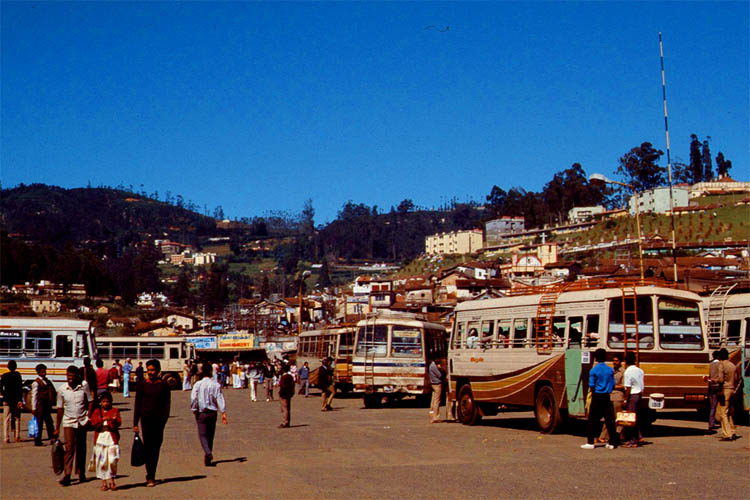
| but by bus again to the next part
|
Mysore
Ok, the next part of my trip was visiting the other palace of the maharaja, the Palace of Mysore. Unfortunately, I couldn't stay in that one. So I had to settle down in a cheap guesthouse in the middle of the city from where I could easily walk to the palace.
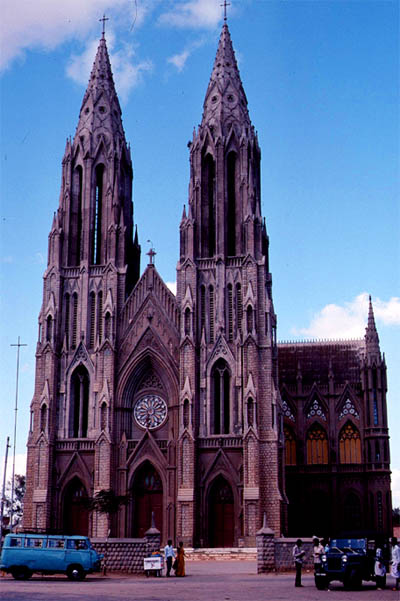
| First I passed a Gothic church
|
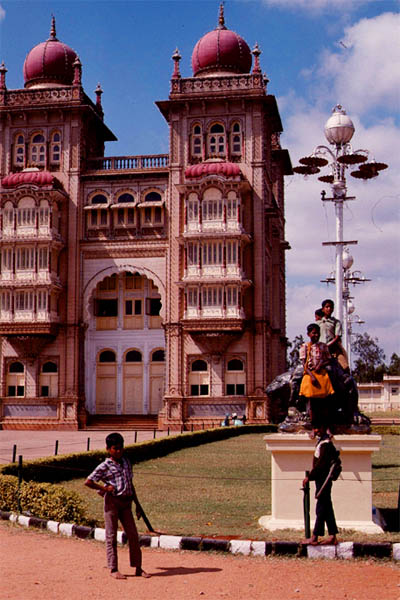
| This looks like an Orthodox church
|
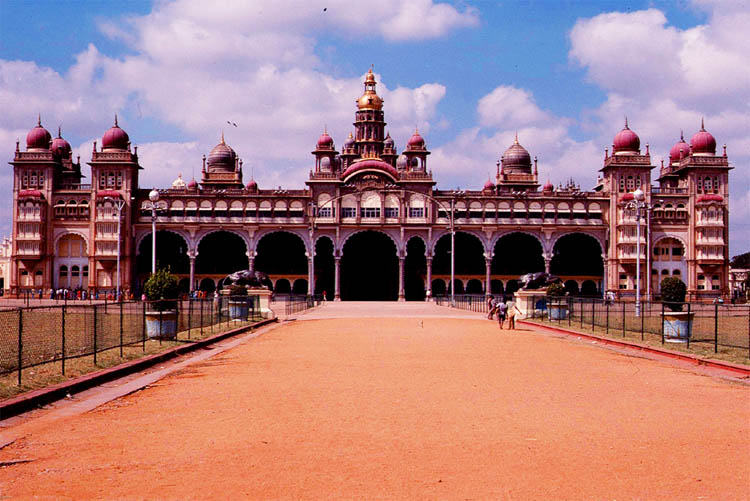
| Oh, what a sight and splendor
|
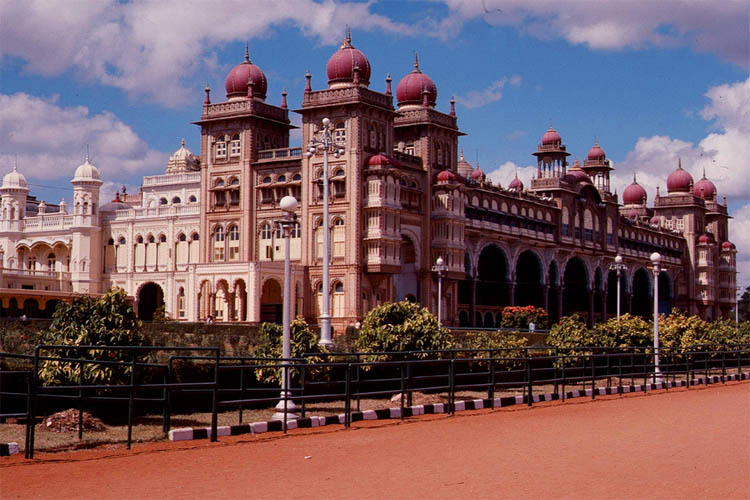
| It's the palace of Mysore
|
This is the seat of the maharajas of Mysore and was designed by an English architect and finished in 1912. Not much to describe. Look for yourself. Photos inside were not allowed but you can assume the same splendor as from the outside.
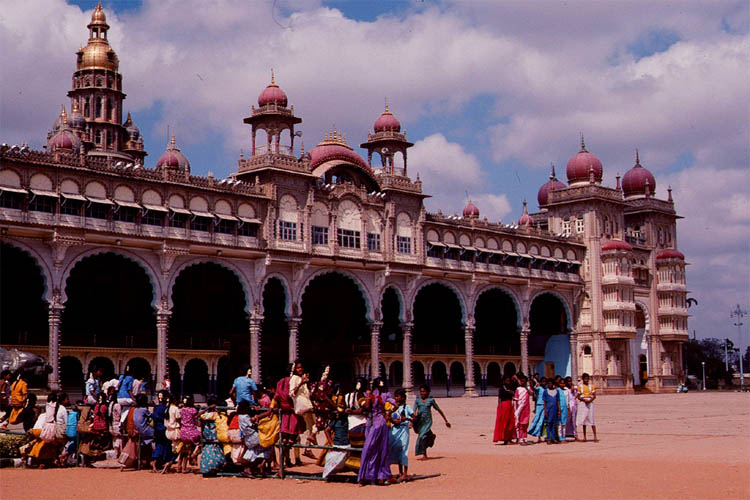
| Visited as part of the Indian history
|
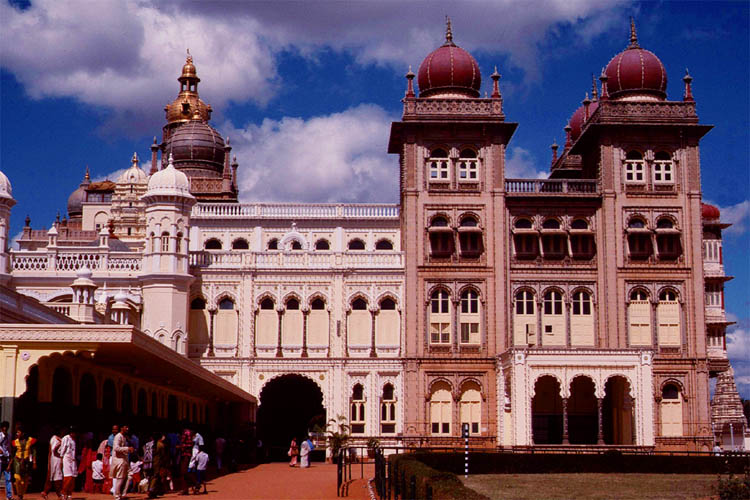
| not always kept in good memory
|
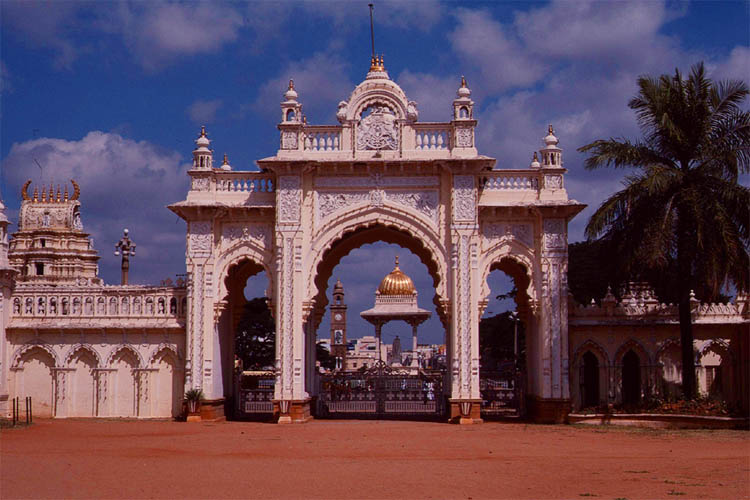
| The gate to heaven or to wonderland
|
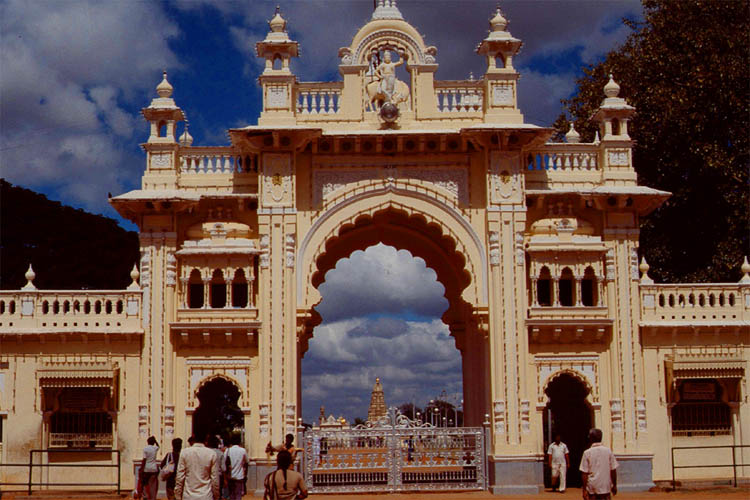
| Built when wealth was held in one hand
|
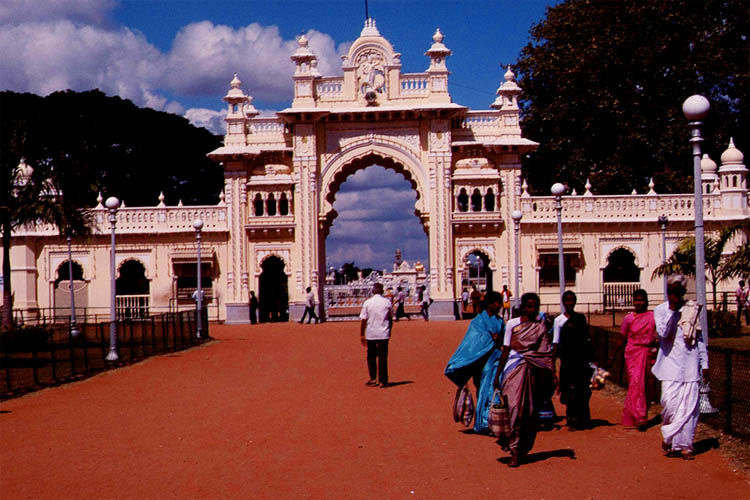
| A very well situated middle class now exists in India
|
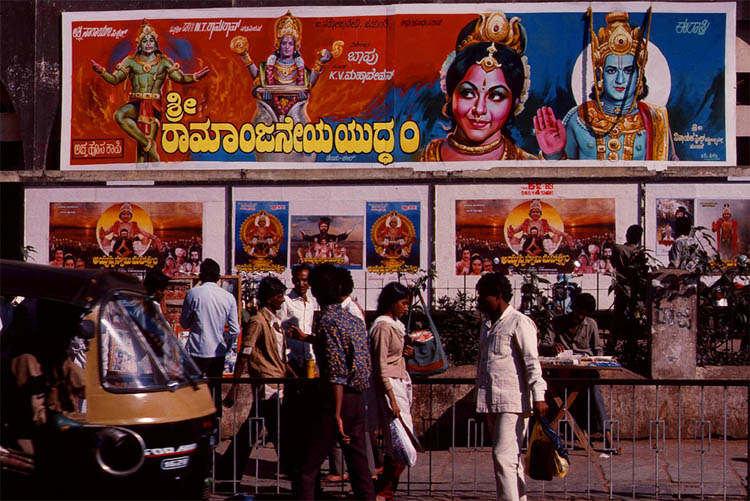
| But many still love to watch the old stories in the cinema
|
I couldn't walk to the many other interesting places around Mysore, so I joined a daily sight-seeing tour offered by the tourist office. First stop was at the Chamundi Hill. The top is dominated by a wonderful 40 meter high gopuram. About one third way down is a stony 5 meter high holy cow, called Nandy, one of the biggest in India.
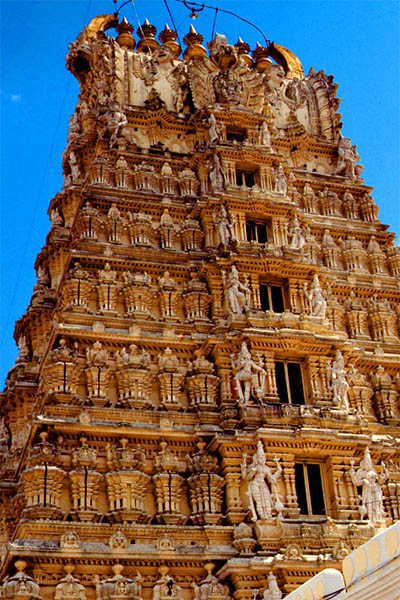
| Indians are still very religious up to now
|
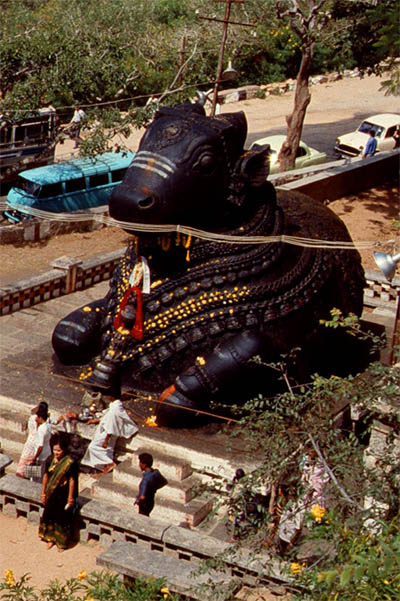
| and still worship the holy cow
|
It would take too much time to elaborate about Indian history and why the British so easily conquered it. But since India was always a battle ground between feuding Indians, the British took advantage of that by taking either side of warring parties. One example is the defeat of the former ruler of almost all of southern India. His name was Tipi and his impressive mausoleum you see below.
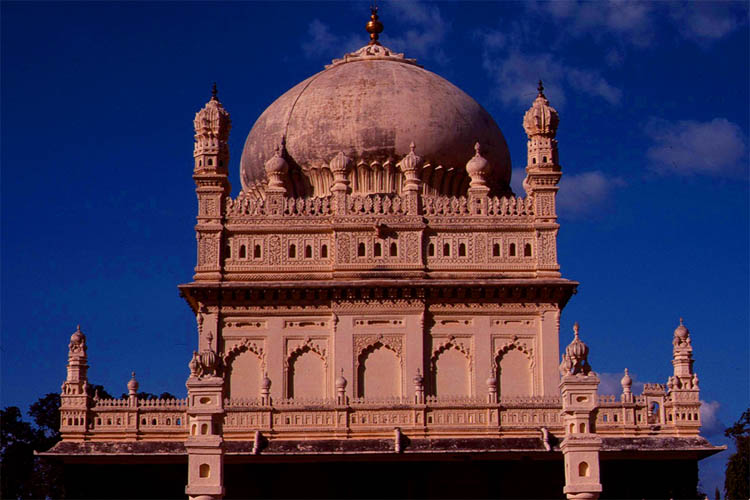
| Indians are known for their good workman-ship
|
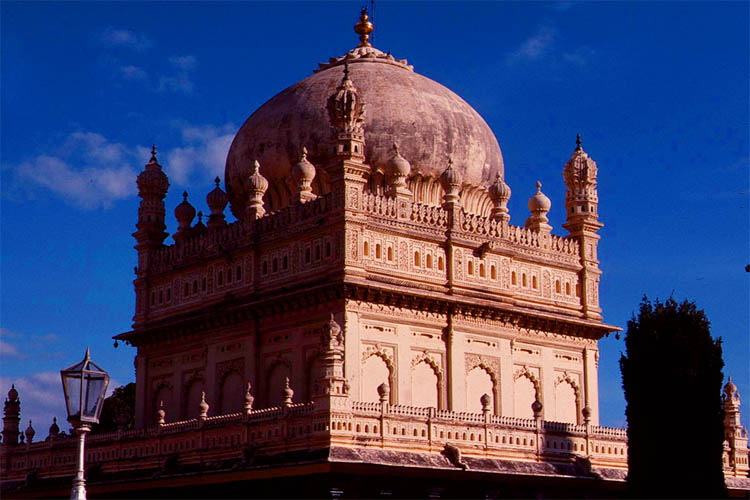
| And they are also proud of their heritage
|
Brindavan Gardens
This beautiful garden with ponds and fountains is below a huge lake held back by a hydro plant dam.
While wandering around I had an interesting conversation with an Indian teacher from Madras who also was traveling alone and had joined the same tour.
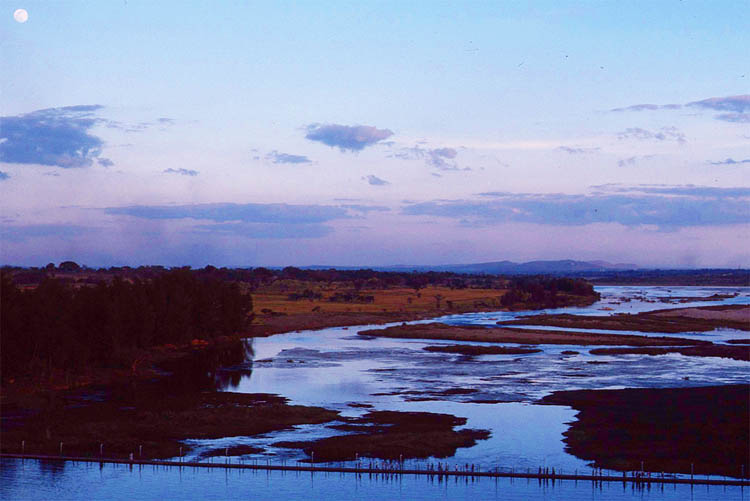
| Indians are known for their special techniques
|
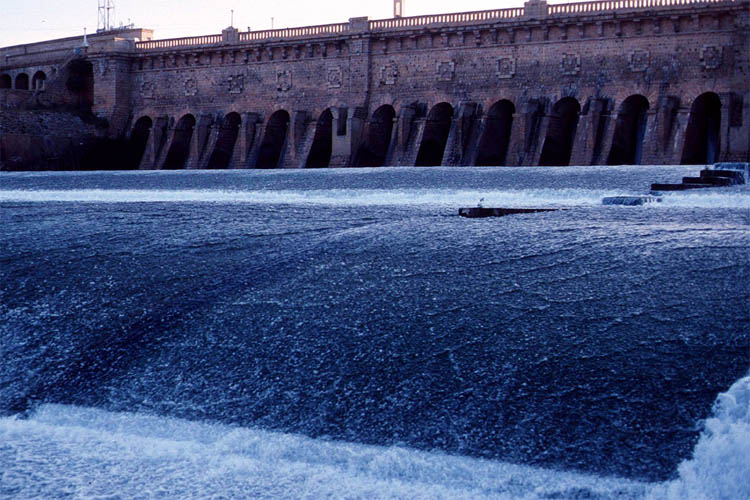
| To be able to build a power station dam like this
|
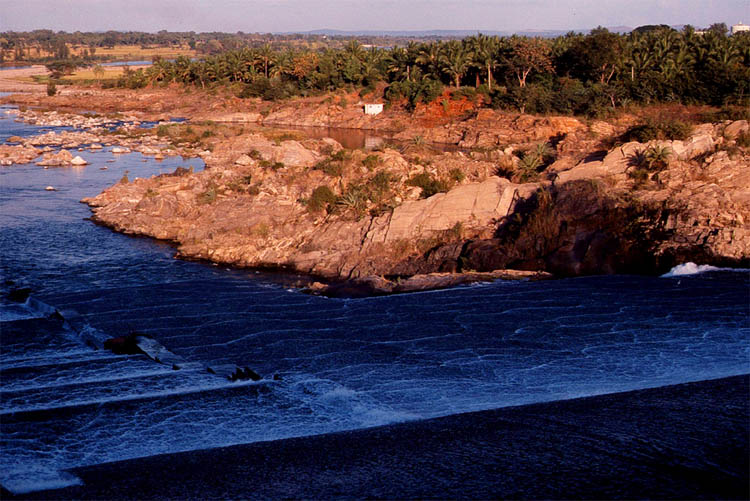
| And close to this fantastic waterscape
|
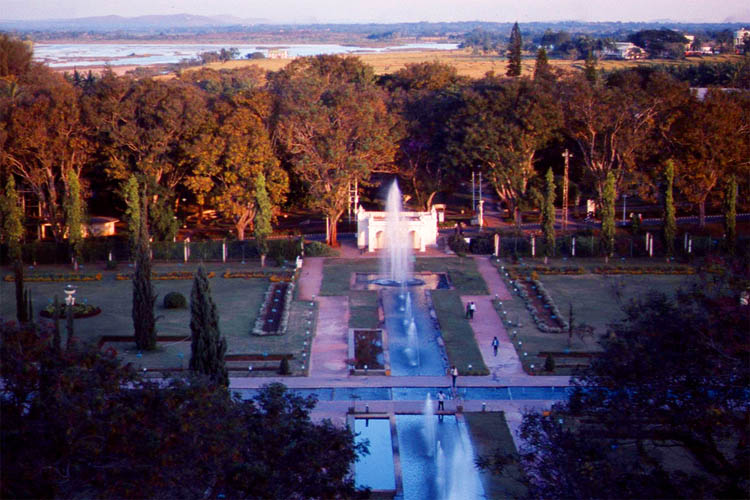
| They have built a beautiful landscape
|
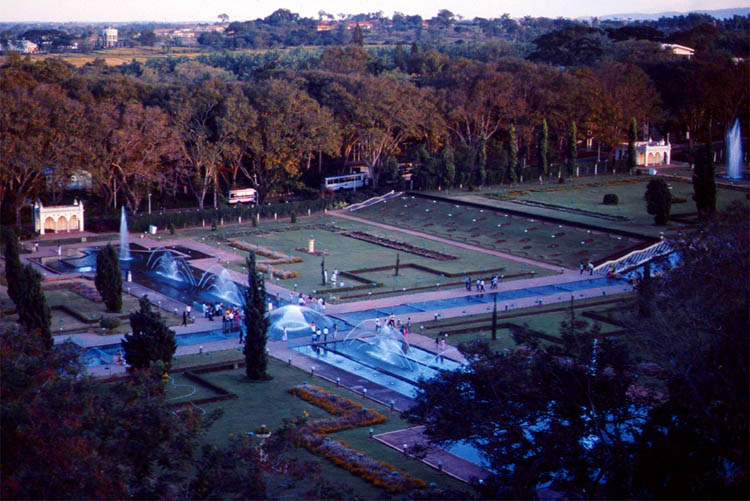
| With fountains glistening in the sun
|
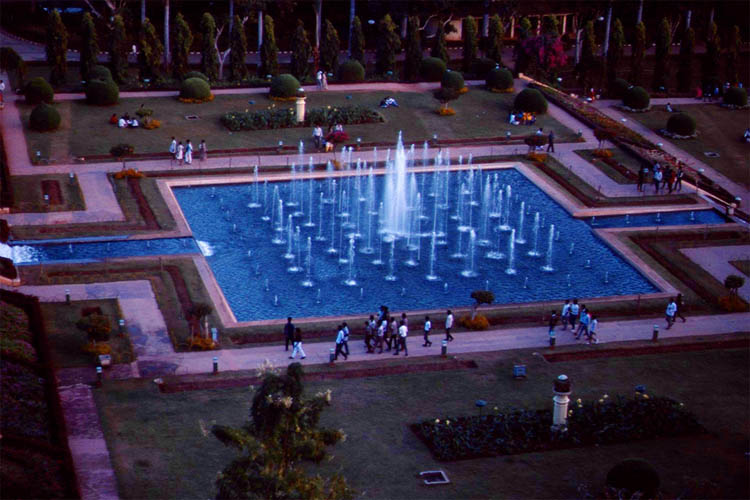
| and pools supplied through the dam
|
Sravana Belgola
Next sight was a hill. But what a hill. It's one of the oldest and most important Jain pilgrimage centers in India, and the site of the huge 18 meters high naked statue of Gomateshvara, a Jain deity, on top. At first I thought that he was Buddha. What similarity. It actually was around the same time, the sixth century BC, as the Jain founder, known as Mahariva, was preaching almost the same philosophy as Buddha. Mahariva was not very well known in the West, but more Indians believe in Jainism than Buddhism.
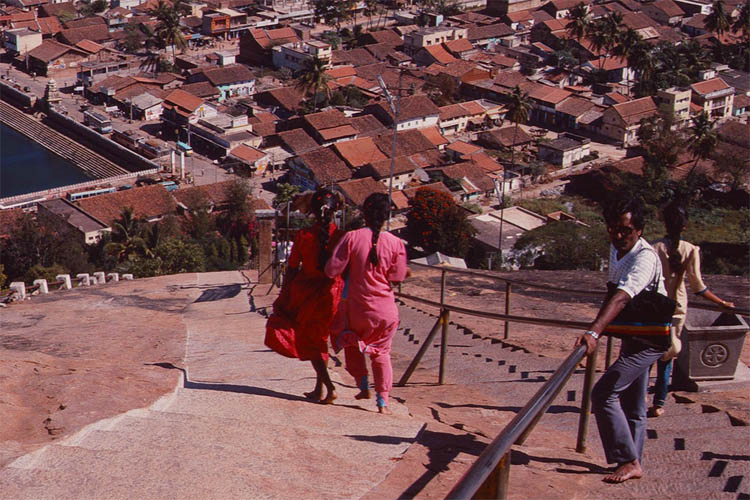
| The staircase to heaven was steep
|
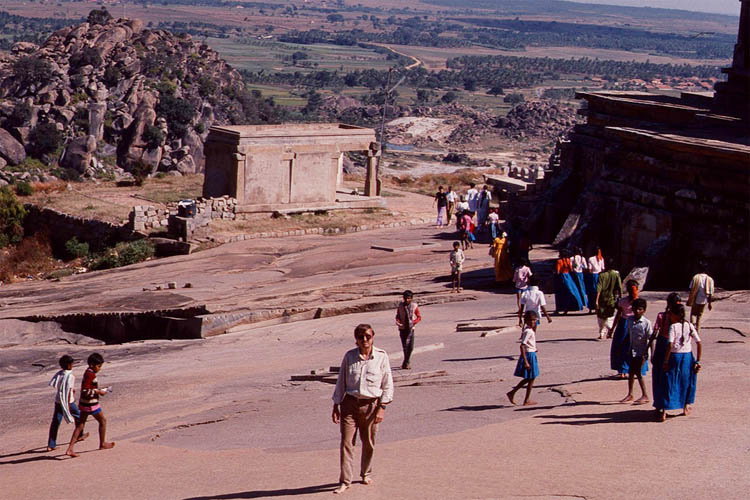
| then walking up a slope in the heat
|
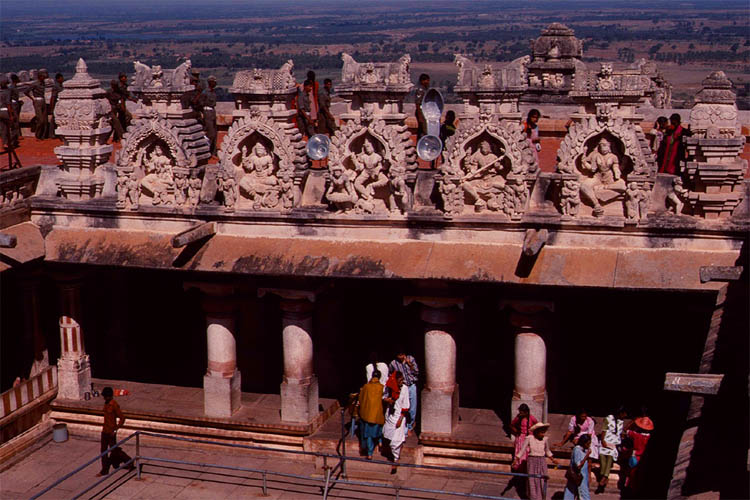
| When we finally reached the temple it was nice to look at
|
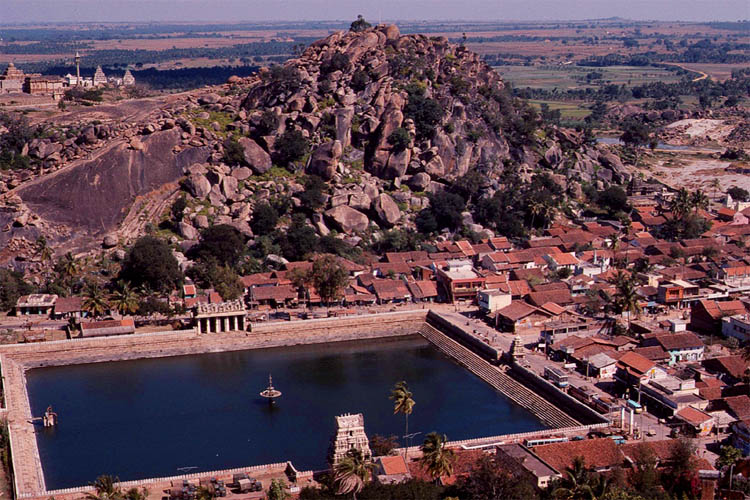
| but with the view down we were even more awarded
|
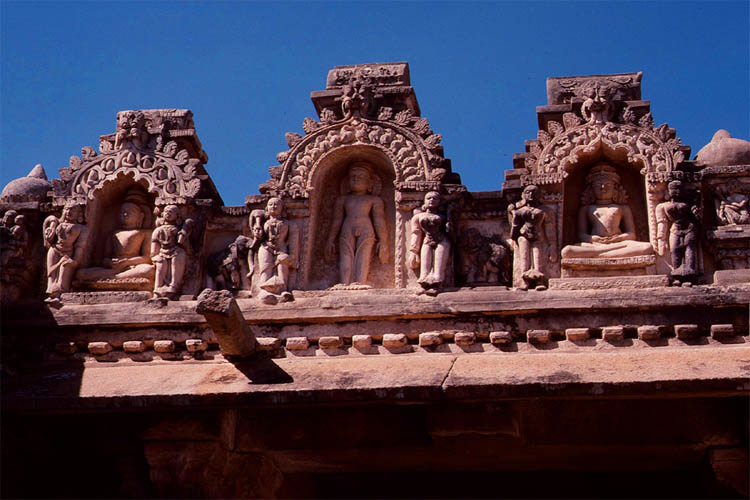
| No Buddhas but Jain gods are sitting and standing along the frieze
|
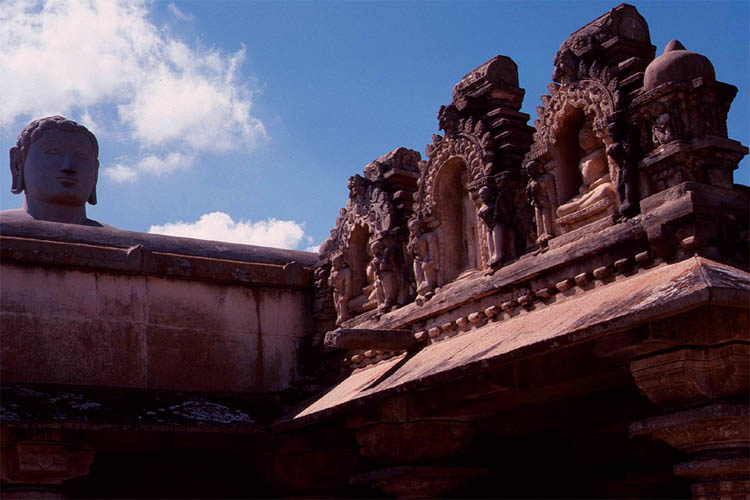
| No Buddha but a Jain god head. Where is the rest of that piece?
|
That naked guy is already 1000 years old but looks as new as ever. No wonder with all those cosmetics put on him every twelve years: coconut milk, yoghurt, dates, almonds, poppy seeds, sandal wood, saffron and a lot of ghee, that liquid rancid butter. Maybe I should try that on my body, too.
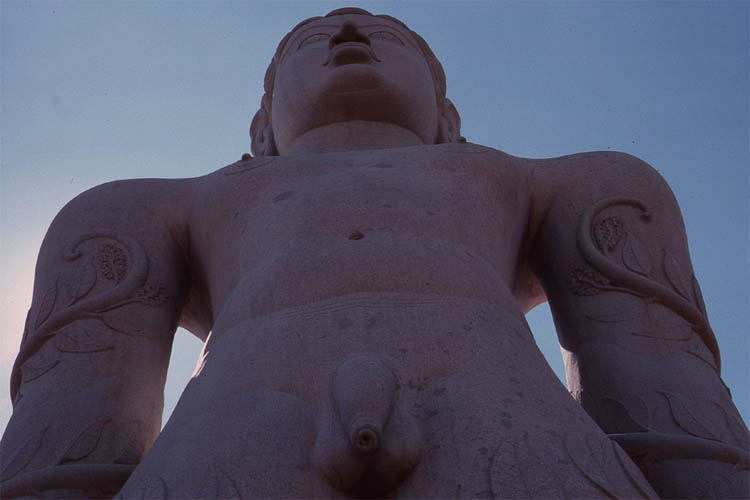
| Oh yes, that penis is really a big piece
|
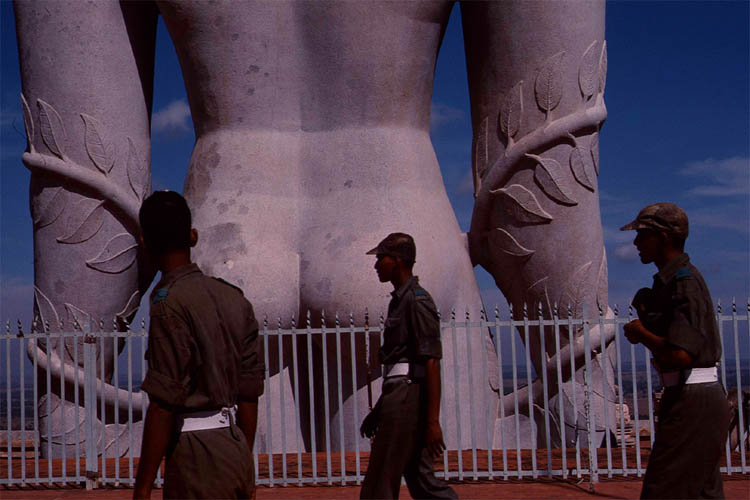
| And the back must be guarded by the police?
|
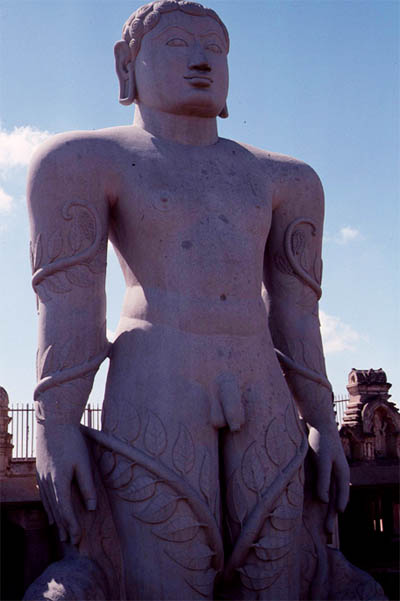
| Can you imagine now how big he is
|
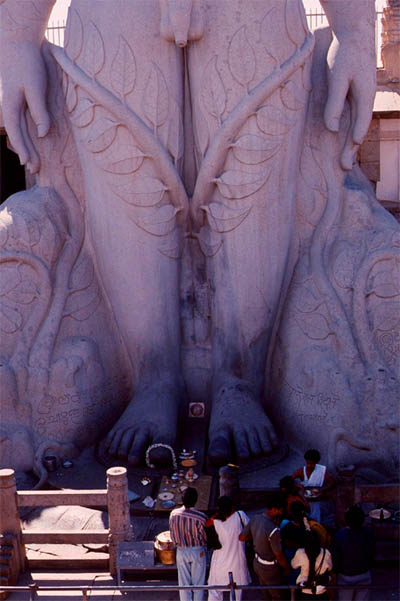
| by looking at the people beneath
|
Some words about Hinduism, especially re-incarnation. Every Hindu thinks that he will be reborn. But as what? A worm, a dog or as a human being again? That all depends on his good or bad deeds (his karma) in his current life (what good or bad can a worm do?).
According to my teacher from Madras, being born as a human being is the greatest (of course), but being born as a man is even more great than greatest, and being born as a Brahman is the ultimate greatness. My question was: what is better: Being a man in the untouchable caste or a (touchable?) woman in a higher caste? The answer: gender ranks before caste. To proof his point he gave me a booklet about that subject to read the same night.
He may have been right that it is better to be a man than a woman, but only as far as Hindus are concerned. Most girls or women in India lead a miserable (and dangerous) life, if they are not aborted right away or killed directly after birth. Girls are further decimated through neglect (dying of malnutrition or of no medical care, especially in families with no son or more than one daughter).
A girl or woman is dominated by men her whole life, first by father and brothers, then by the husband and sons. The father chooses her husband, possibly a "cheap" one with no high dowry demand (actually illegal). As a wife she is often killed by her husband (most deadly household accidents of women occur in India) for more dowry with another potential wife. Unmarried or widowed women are "nothing", ending up in some brothels and/or on their last trip to "heaven" in the holy water of the Ganges.
That is the sad part of Indian society.
If you want to skip now to the next part, then just hit
Part III - Goa, Bombay
| 
















































































































